Marketing Spotlight: Databricks’ Marketing and Sales Strategies
Article summary
Share
In this article, we put Databricks in the “Marketing Spotlight” as we take a closer look at how their sales and marketing strategies are working and what sets them apart, as they were in February 2025.
Why? Because we love a good challenge and want to help fellow marketers take inspiration from companies that are getting it right. So get comfy and enjoy the read; it’s going to be a good one!
Moreover, we heard some good news about Databricks. In December 2024, they raised a $10-billion Series J equity funding round, to “support employee stock cash-out, AI talent hiring, and M&A”. This raised the company value at $62 billion.
Knowing this, we decided to take a closer look at how the data & AI U.S. market looks, where the AI hubs are located, and who the big players are. With this analysis, we want to help marketing leaders understand the market landscape and its dynamics, enabling them to create better strategies for their companies.
(PS: If you need help, wink-wink, send us a message. We have Milk & Cookies and good strategies).
📝 A quick note before you start reading:
The data and analysis in this article are valid as of the time we wrote it. We don’t know when you’ll be reading this, maybe next week, maybe six months from now, and things might have changed since we looked at this company’s marketing and sales approach. Still, the insights and lessons here stay useful, even if the numbers or tactics have evolved a bit.
Understanding the company

Databricks is a software development company founded in 2013, with headquarters in San Francisco, CA, USA. Databricks is a data intelligence platform powered by generative AI, helping businesses integrate AI and data into their operations.
At the time of this analysis, Databricks had approximately 10,300 associated members on LinkedIn, with a median tenure of 1.9 years. Most of their employees are engineers (approximately 4.5k), followed by sales professionals in second place, with approximately 2.1k employees. The marketing department has approximately 360 people.
Databricks has offices around the world, in at least 17 countries. In February 2025, they had 670 open positions.
We examined their careers page to understand if they intend to grow in certain directions and what their future plans might be. Here are some insights:
- They have a large number of open positions for engineers (software engineers, multiple levels and specializations, engineering managers, to data scientists and research scientists). This might indicate they are planning to invest in product development and innovation. They seem especially interested in backend systems and databases, which probably means they’re working on making their platform even more powerful and reliable.
- They’re hiring also sales professionals and related Go-to-Market functions (Business Development, Solutions Architects, Field Engineering, etc.) to expand their customer base and their market reach.
- They are also hiring across other functions like Marketing, Finance, Legal, IT, and People/HR. This suggests a holistic growth strategy, with investment in all areas of the business to support the overall expansion.
What does the data and AI market in the U.S market look like?
The U.S. artificial intelligence (AI) market size was estimated at $123.07 billion in 2023 and is predicted to reach around $851.46 billion by 2034, growing at a CAGR of 19.3% from 2024 to 2034.
P.S: A big thank you to the Veridion team for the amazing data that they’ve provided to allow us to write this article.
Databricks’ Brand Promise
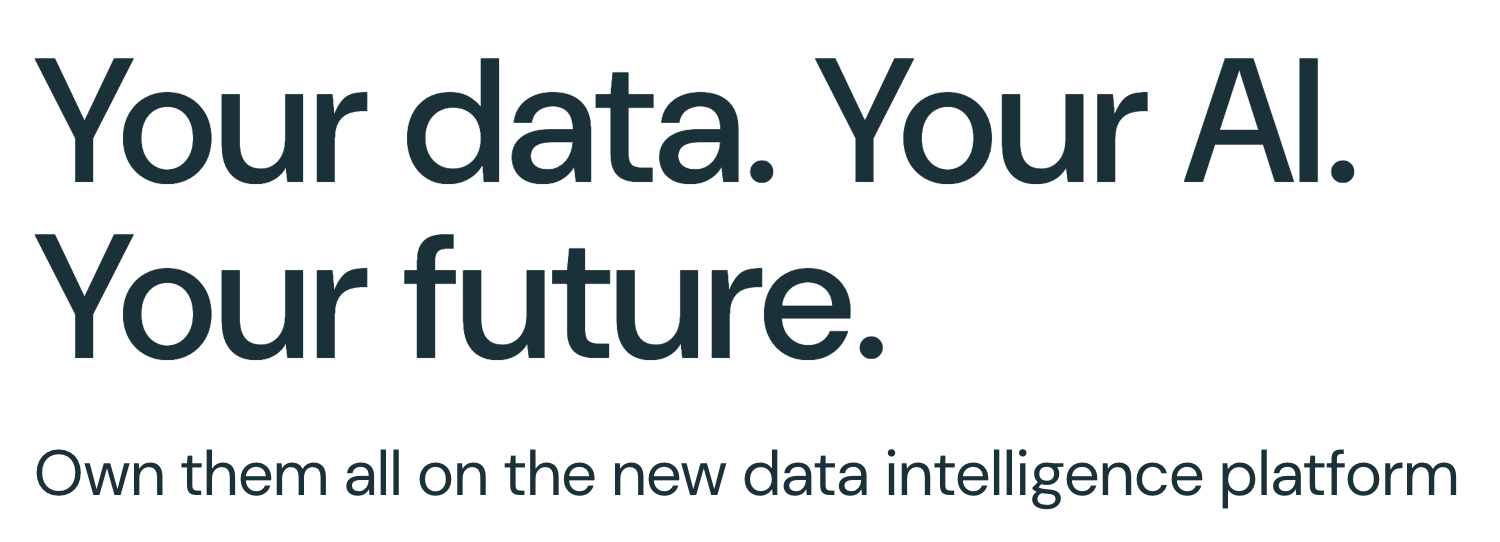
This is Databricks’ brand promise. Upon closer examination, we can extract some main ideas. First, they enforce the idea of data ownership (“your data”). This emphasizes the concept of control and belonging. With their data, companies can develop their own AI applications, empowering them to harness the power of AI. This idea is further accentuated by statements like: “Databricks brings AI to your data to help you bring AI to the world”.
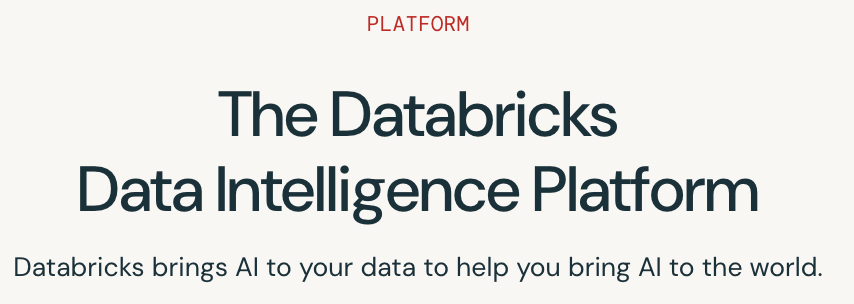
It’s worth noting how clear their communication is. It’s quite easy to understand what they’re trying to convey.
Their brand promise is also future-oriented. Your future aligns with Databricks’ vision of empowering organizations to drive innovation and transformation through data and AI.
And last, but not least, the “own them all” phrase is at the epicenter of their services, namely their Databricks Data Intelligence Platform, which combines data, AI, and governance in a single solution.
Databricks’ Services & Products
Their main product is their Data Intelligence platform. Databricks promotes it by highlighting its value proposition.

Databricks understands that AI is no longer a futuristic dream, but a present-day necessity for businesses. They offer a helping hand, empowering you to “Succeed with AI”. This solves a major problem for businesses looking to use AI without compromising sensitive information.
They also believe that data insights shouldn’t be confined to only a few people. Databricks aims to “Democratize insights“, making the power of data analysis available to everyone in your organization, regardless of their technical background. Imagine your whole team, from marketing to sales, being able to easily ask questions of the data and get clear, understandable answers. That’s the kind of accessibility Databricks wants to offer their clients.
Databricks promises to “Drive down costs” by offering a unified approach to data, AI, and governance. This consolidation simplifies complex data ecosystems, potentially reducing operational costs and improving overall efficiency.
Of course, after these highlights, immediately it follows a CTA: “explore the platform”.
Their solutions span across multiple industries, such as Manufacturing, Retail media, and many more.
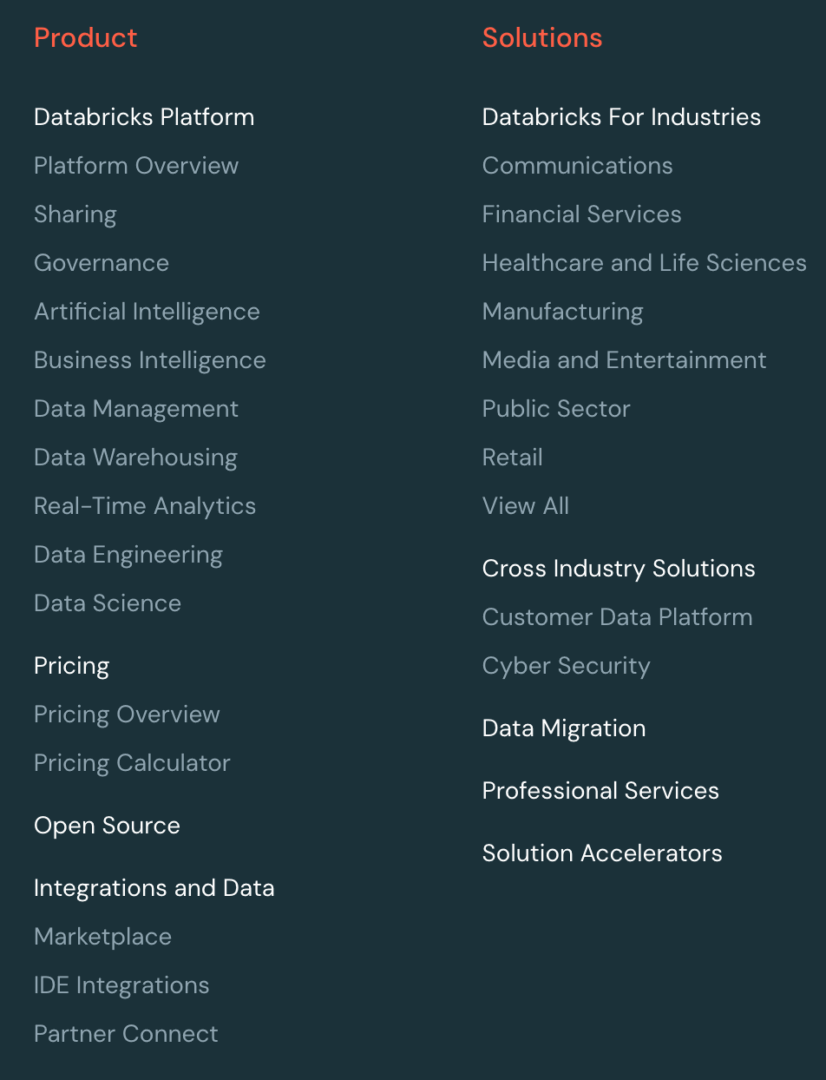
How do they differentiate themselves
We first looked at their LinkedIn “About page” to understand what they consider their key differentiators.
They emphasize the idea that “Databricks is the Data and AI company”. They also point out how many organizations around the world use their services, and they name-drop some pretty big players. These companies are not randomly chosen, they are leaders in their respective industries. Consider Comcast, a large corporation in mass media, or Shell, in the energy sector.
On top of that, they are not shy to mention that they collaborate with Fortune 500 companies with the statement: “over 60% of the Fortune 500 — rely on the Databricks Data Intelligence Platform to take control of their data and put it to work with AI”.

“Databricks is the data and AI company” is the tagline used by Databricks to succinctly describe their core identity and focus. We see it not only on LinkedIn, but also in the “About us” section from their website.
“Now, anyone in an organization can benefit from automation and natural language to discover and use data like experts, and technical teams can easily build and deploy secure data and AI apps and products.”
Databricks wants to make data and AI easy for everyone to use. They’re saying that you don’t need to be a tech expert to get useful information from data or to create apps that use data. This is great for:
- people who aren’t tech-savvy, because they’re making it easier to get insights from data by using automation and letting you ask questions in plain language.
- tech teams, because they’re making it simpler to build and launch secure apps that use data.
Of course, in the About Us section we also see their clients, with big names like: Toyota, Adobe, Mars, and S&P Global.

Now, do you know what this list means?

This is a list of Databricks’ investors, which is a key differentiating factor for the company. Having such a diverse and prestigious group of investors demonstrates Databricks’ strong market position and potential for growth.
This list of high-profile investors differentiates Databricks by:
- Validating their business model and technology
- Providing substantial financial resources for growth and innovation
- Offering strategic partnerships and industry connections
- Enhancing credibility in the market
- Demonstrating long-term viability and potential for success
Conclusions
After exploring Databricks, a few key things stand out. Their team is substantial, with a strong engineering core, and they’re clearly growing, considering the big number of open positions.
Databricks’ brand promise revolves around empowering businesses to truly own their data and use it to drive innovation. They emphasize control, accessibility, and a future-focused approach. Their core offering, the Data Intelligence Platform, is designed to bring data, AI, and governance together in one streamlined solution, making it easier for businesses to “succeed with AI“, “democratize insights”, and “drive down costs”.
Social Media Leadership’s Presence
Now let’s have a look on how the Leadership from Databricks uses social media and if they promote the company.
CEO & co-founder – Ali Ghodsi
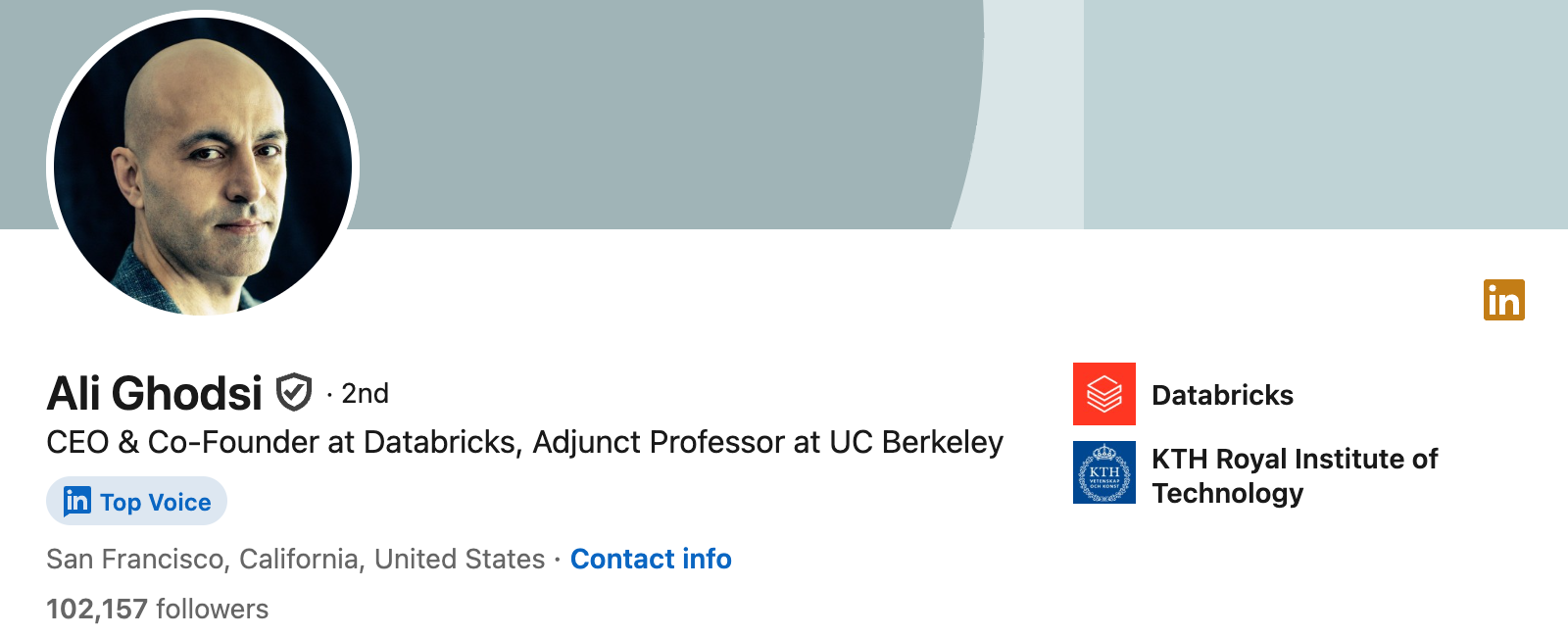
We can immediately observe that the CEO has a large number of followers ( over 102k!). The CEO is quite active on LinkedIn. But how often does the CEO post? Sometimes he posts four times a week, and sometimes just once. The CEO shares original content, rarely uses CTAs, as you will see, but he is very active here.
The CEO is mostly focused on promoting the company and its services. For example, in this post, he mentions a new Databricks feature for business intelligence professionals:
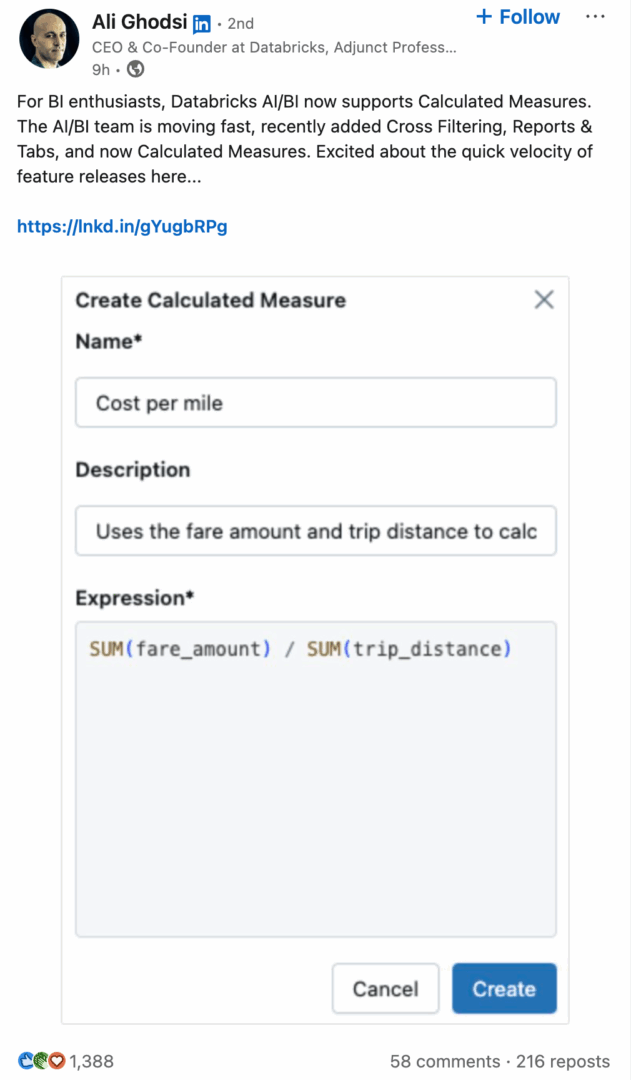
You may have noticed the large number of reactions to this post (1.3K), as well as the number of comments (58). We examined the comments and it seems that the CEO does not directly engage with them. However, other Databricks dedicated employees are actively replying in the comment section.
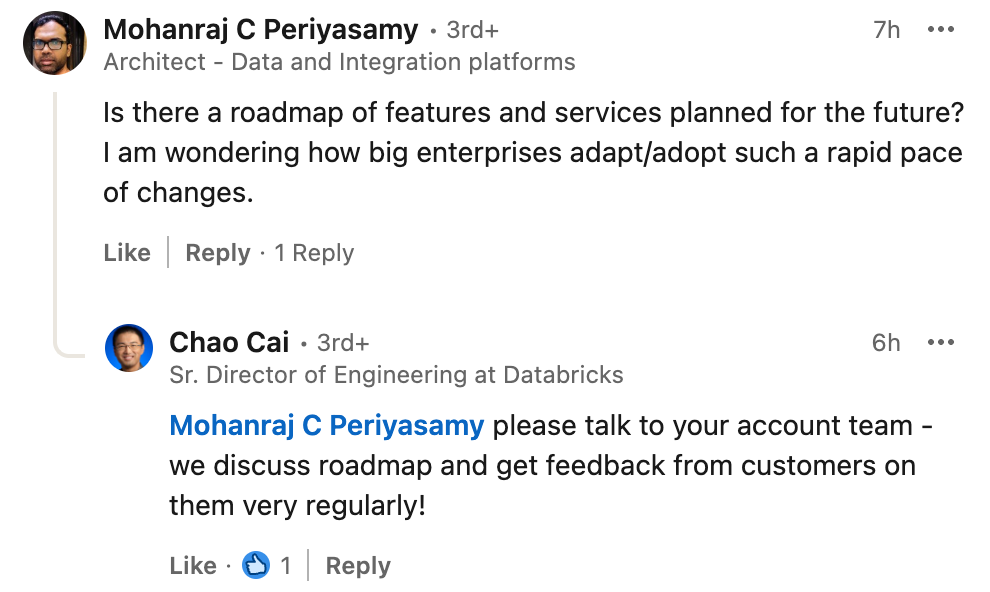
Here is another post on their platforms’ update:
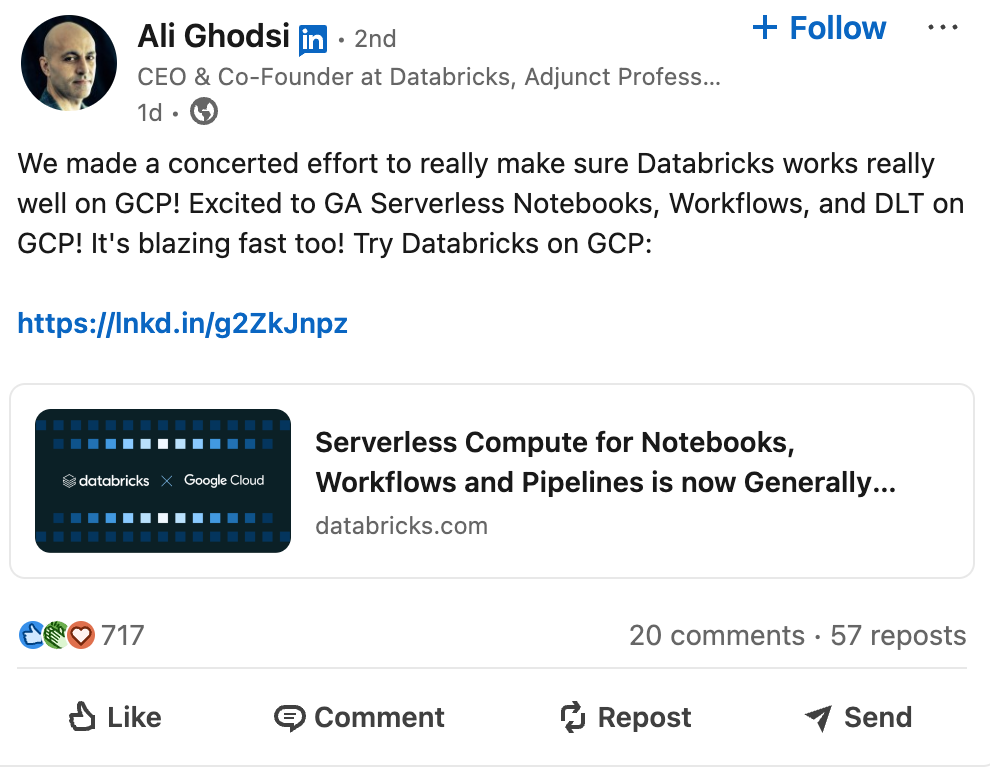
Sometimes the CEO sprinkles some promotional content in this posts and subtly incorporates client testimonials as part of the strategy.
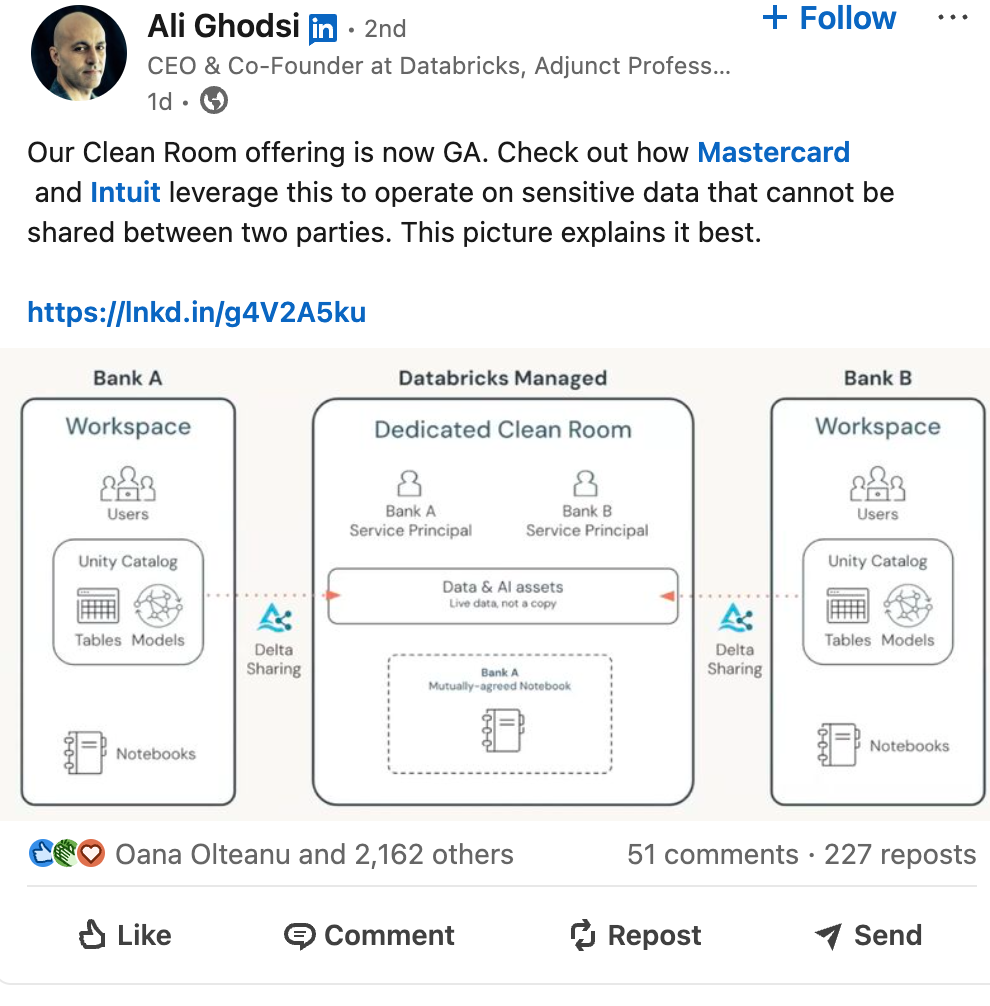
While there is not a direct “Learn More” CTA button, the link provided encourages engagement and further exploration of the offering. The post explicitly names two well-known companies, Mastercard and Intuit, as users who “leverage this” (the Clean Room). This acts as a testimonial, implying that these reputable organizations find value in the product.
Having the CEO share the news on his LinkedIn profile adds a touch of thought leadership and makes it feel more credible. It kind of paints Databricks as a leader in data security and privacy.
It is also a good idea to incorporate visuals. Readability is significantly influenced by visual design elements. Good visual design makes content more accessible, engaging, and easier to understand.
We also appreciate that the CEO seems to put time and effort into his LinkedIn content. Take for example his recent video showcasing DeepSeek R1 on the Databricks platform. This is also a way to demonstrate how easily the integration works with their platform. When the leader of a company is actively using and showcasing their product, it sends a strong signal of confidence and belief in its value. Seeing a practical demonstration can also inspire potential users to explore the platform and try it for themselves.
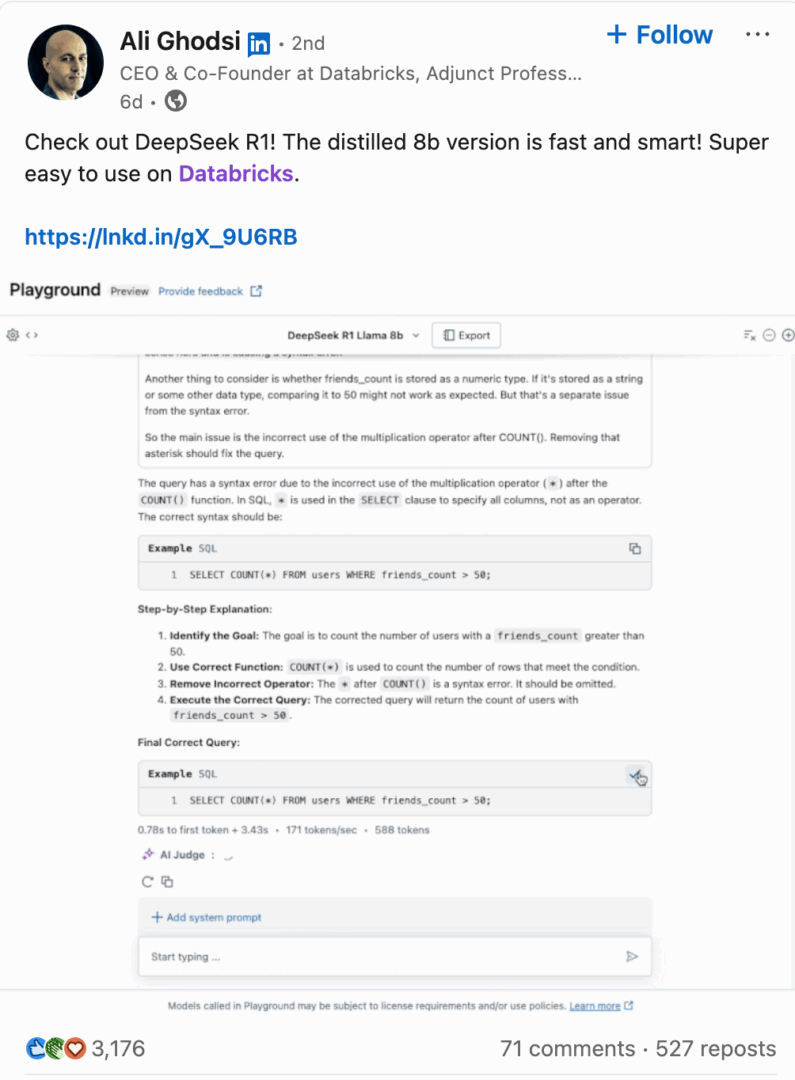
As a proud CEO, he shares whenever there is good news about Databricks. Here is one example, when Databricks was recognized as one of the winners of the annual Glassdoor Employees’ Choice Awards, a list of the Best Places to Work in 2025.
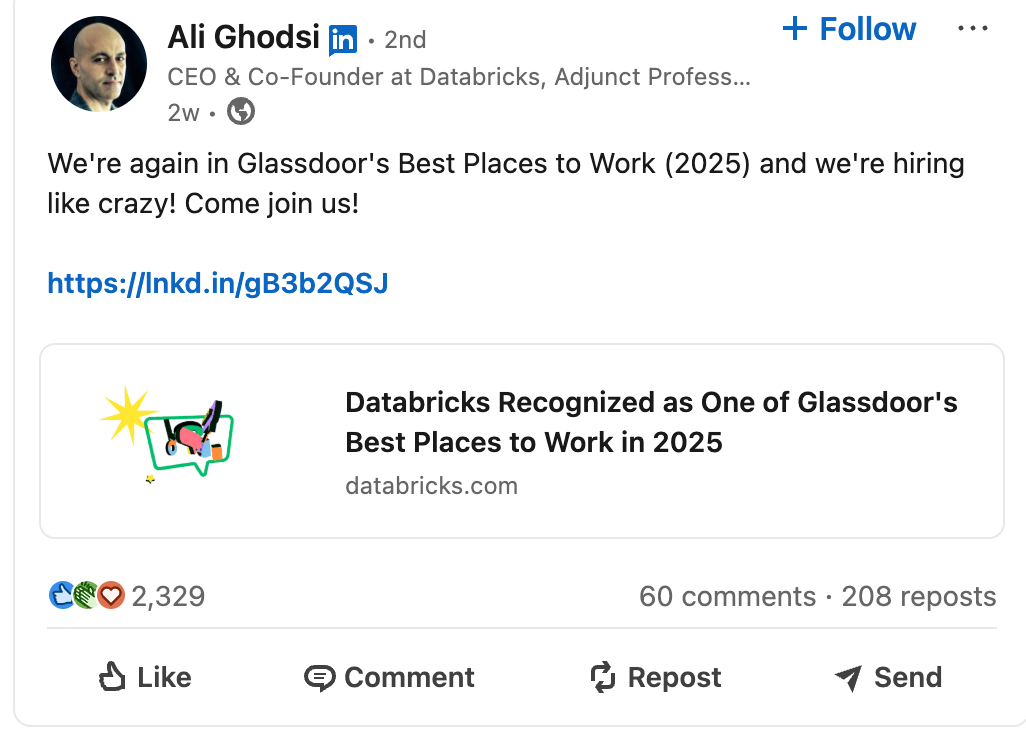
So, we have an idea about his content pillars. Now, let’s examine the CEO’s social selling activity. According to research, businesses that excel in social selling create 45% more sales opportunities than those with low social selling engagement.
When it comes to commenting on posts, it seems that the CEO carefully selects whom to reply to and engage with. One comment that captured his attention was related to Snowflake (one of their competitors).
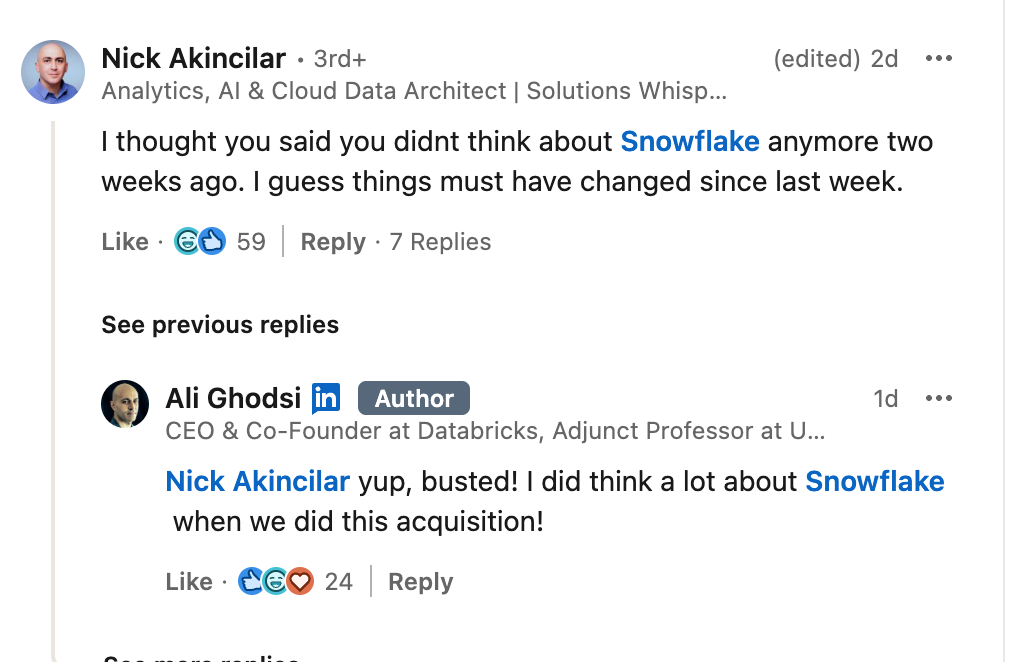
Or sometimes he comments on posts where he is tagged, especially when someone speaks about him with laudatory words. But not only that, don’t get us wrong. He seems to genuinely appreciate others and wants to give back to the community. He has a lot of knowledge to share and clearly values the contributions of everyone who has helped make Databricks successful.
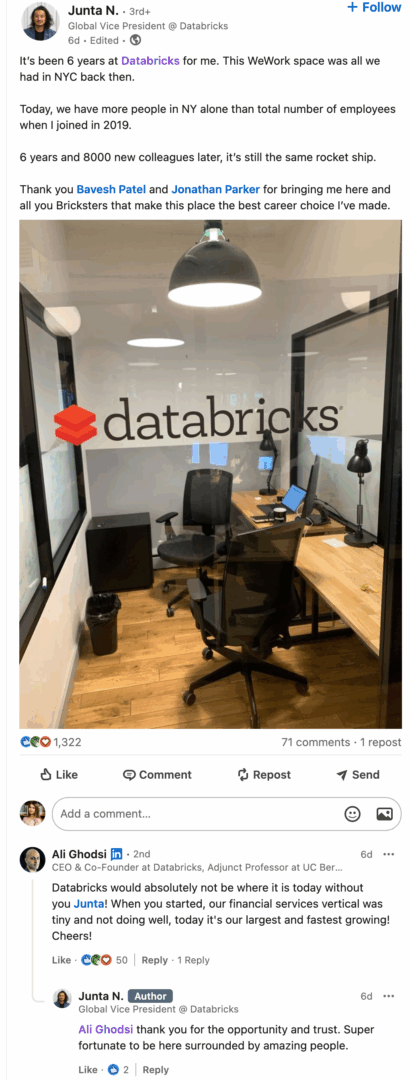
The CEO mostly comments on posts from Databricks employees, professors (he is also a professor at UC Berkeley), posts mentioning Databricks, and posts from other companies. It’s noteworthy that he comments on other companies’ posts. That’s impressive, as it demonstrates his recognition within the industry. We’ve noticed these patterns in his activity, though we’re sure there is even more than that.

In summary, the CEO is very engaged on LinkedIn in terms of posting content. The CEO shows genuine appreciation for others and aims to give back to the community by sharing knowledge and recognizing contributions.
His engagement often attracts responses from other CEOs, indicating his respected position within the industry.
Now, let’s analyze the CMO.
CMO – Rick Schultz
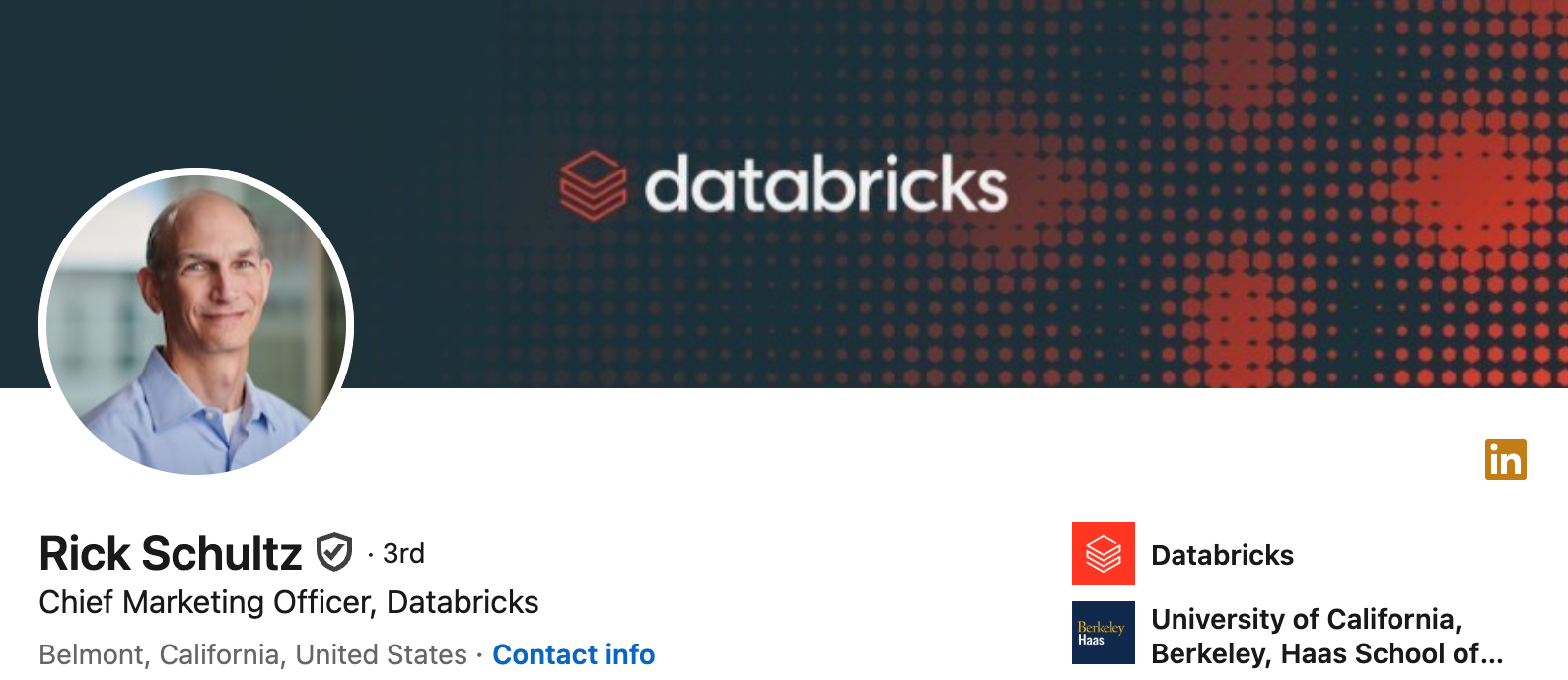
The CMO, Rick Schultz, has 3,782 followers on LinkedIn. Compared to the CEO, the CMO posts much less. He posts about once a month. Compared to the CEO, he mostly reshares posts from other people, adding his own unique descriptions. The posts he reshares are mostly about Databricks.
And we also found that Databricks employees have a nice and unique nickname: “Bricksters”. It’s almost like an internal language, a way to create a sense of community and belonging.

His content gets around 50 reactions per post. Moreover, he replies to comments and engages with others. He puts an effort into building relationships and also improving his social media engagement. Therefore, the CMO is involved in social selling activities.
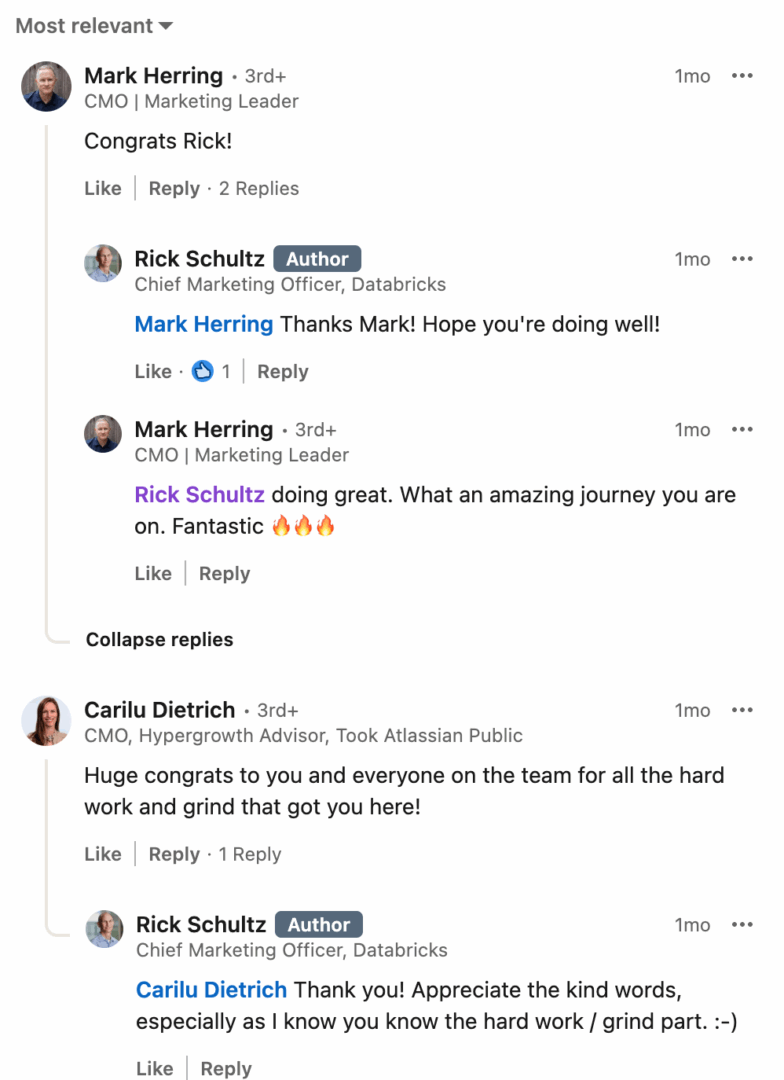
The CMO also promotes articles from the Databricks page, using a simple language, nothing fancy. We appreciate that his writing is very colloquial and it seems very sincere. (“This is a pretty insightful blog… really, one of my favorites this year… which I don’t say lightly as a Knicks (bad Pacers memories from last season) and Warriors fan :-)”).
By mentioning his favorite teams (Knicks and Warriors) and adding a light-hearted comment about “bad Pacers memories,” the CMO is showing his human side and creating a more engaging persona.
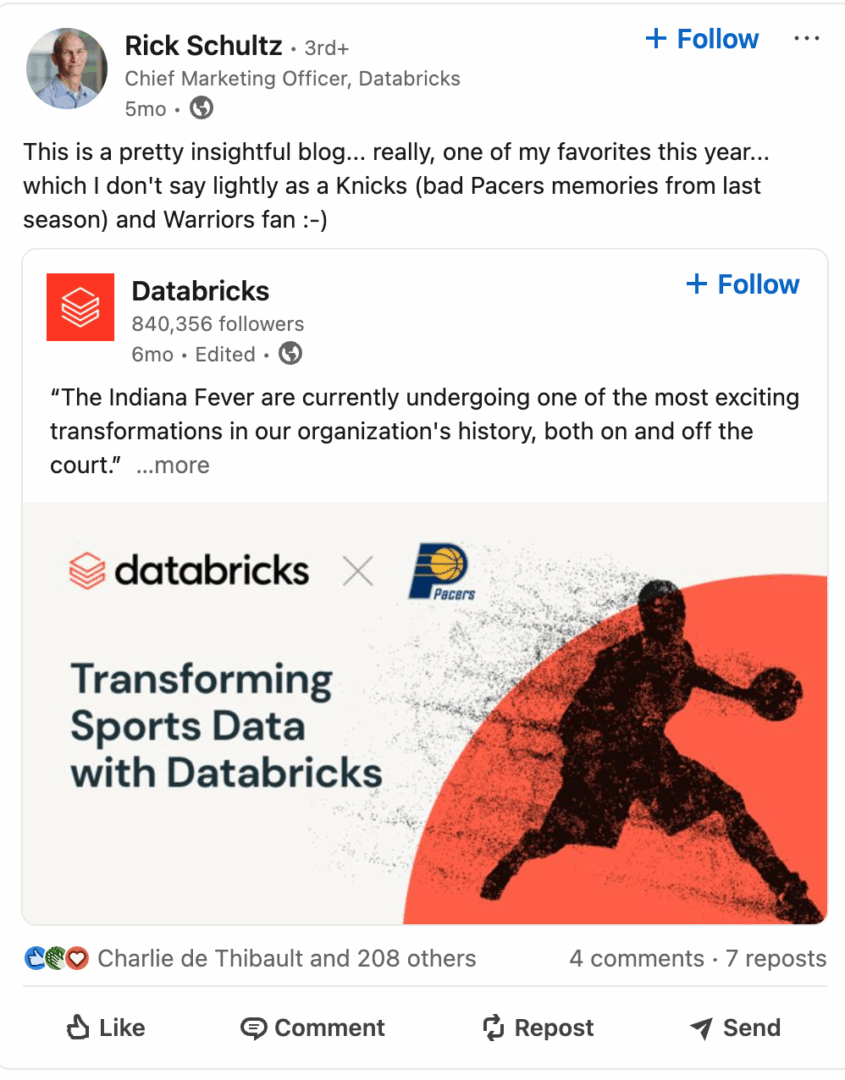
That’s about it. We assume that the CMO focuses his attention on coordinating marketing activities, rather than posting on social media about Databricks. There are some missed opportunities here, however. For example, personal posts from C-suite executives often resonate well with followers and can boost brand credibility. But overall, this does not affect the success of Databricks, as we can all see.
Databricks’ Social Media Activity
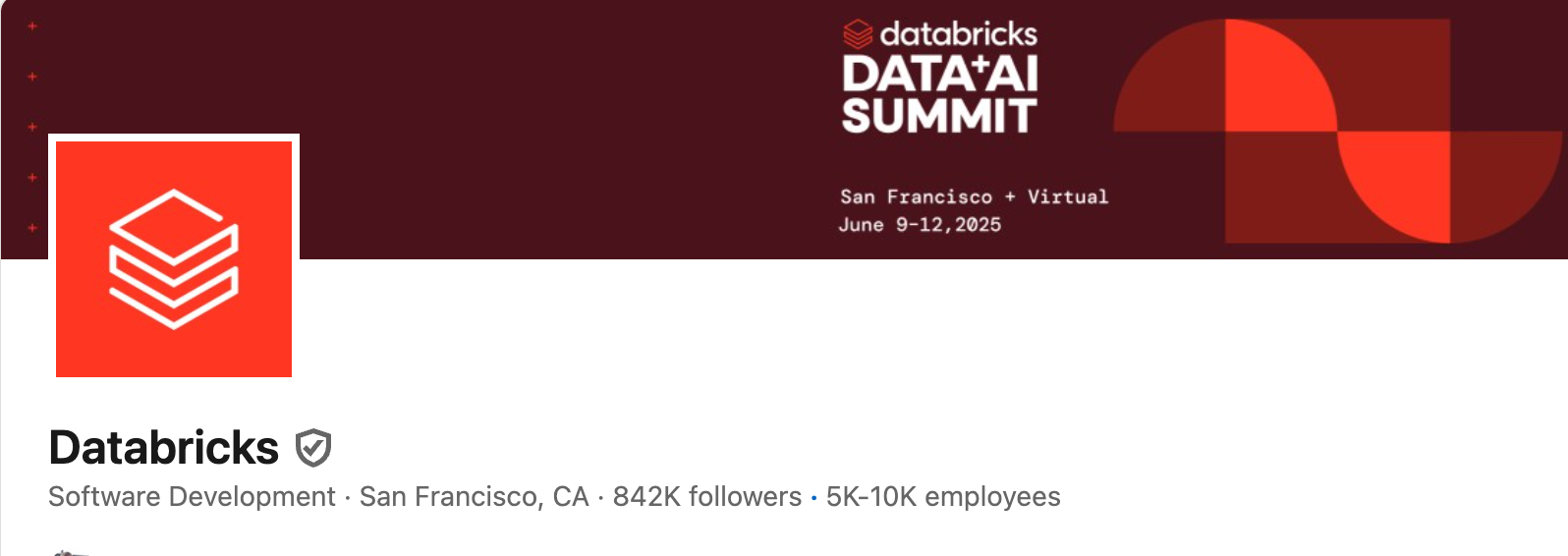
Databricks has a large number of LinkedIn followers (842K) and 10.3K associated members. Regarding posts, we observed that they post around 20 times per month, with an engagement of 250 reactions. Some of their posts reach even 1k reactions!
Here are one of the best performing posts in the last 3 months:
1. This post announces Databricks’ acquisition of BladeBridge. BladeBridge is a company that creates tools to help businesses migrate their data from legacy data warehouses (like Amazon Redshift or Snowflake) to Databricks.
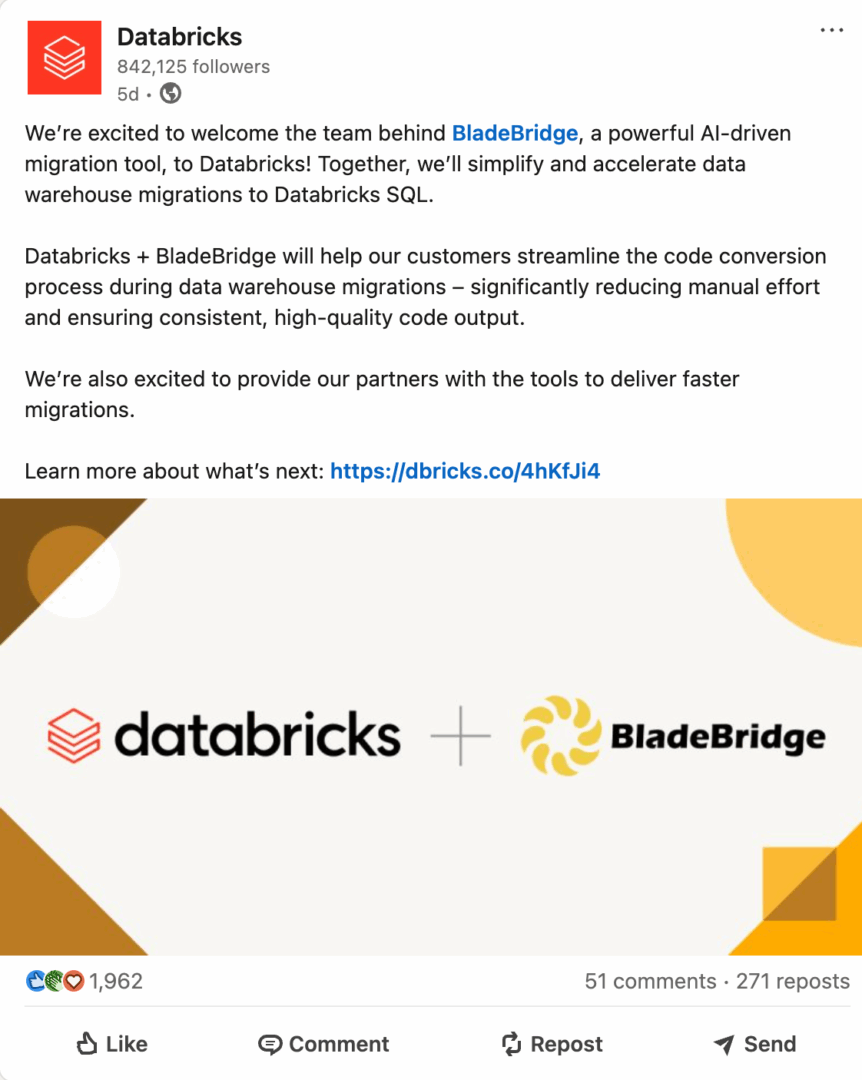
2. This refers to a round of investment where Databricks is selling shares of its company to raise capital.

3. This announcement is about the Databricks Learning Festival, a virtual event designed to help users improve their skills in various data-related fields. This is a way to promote Databricks’ learning and certification programs.
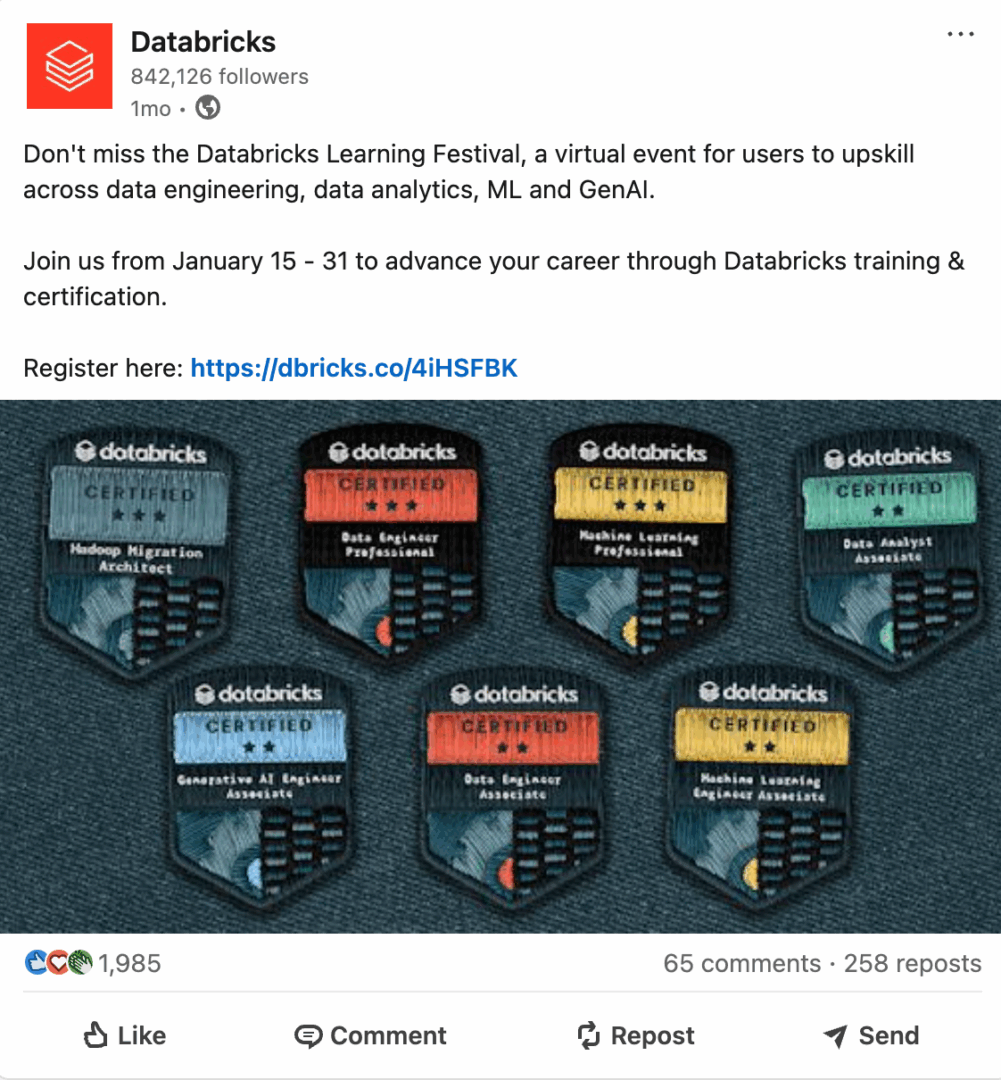
They sometimes react to comments on their posts. However, we haven’t seen them actually replying.
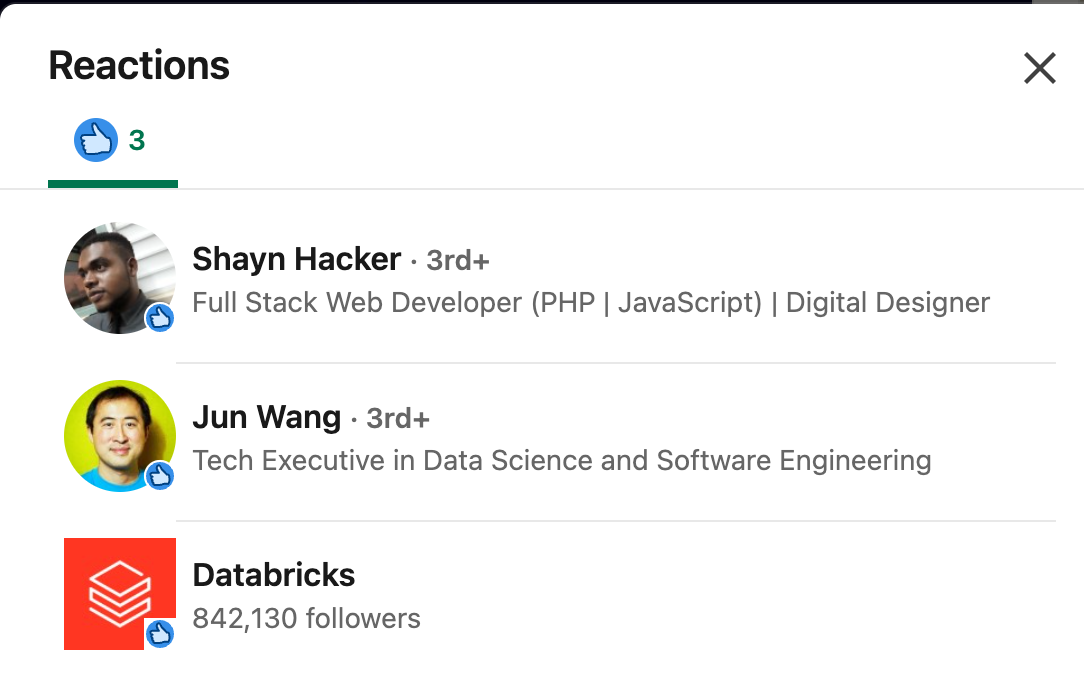
Now let’s analyze what they post, a.k.a the content pillars. We will provide you examples for each type of content pillar.
1. Customer success story (sometimes combined with a thought leadership angle)
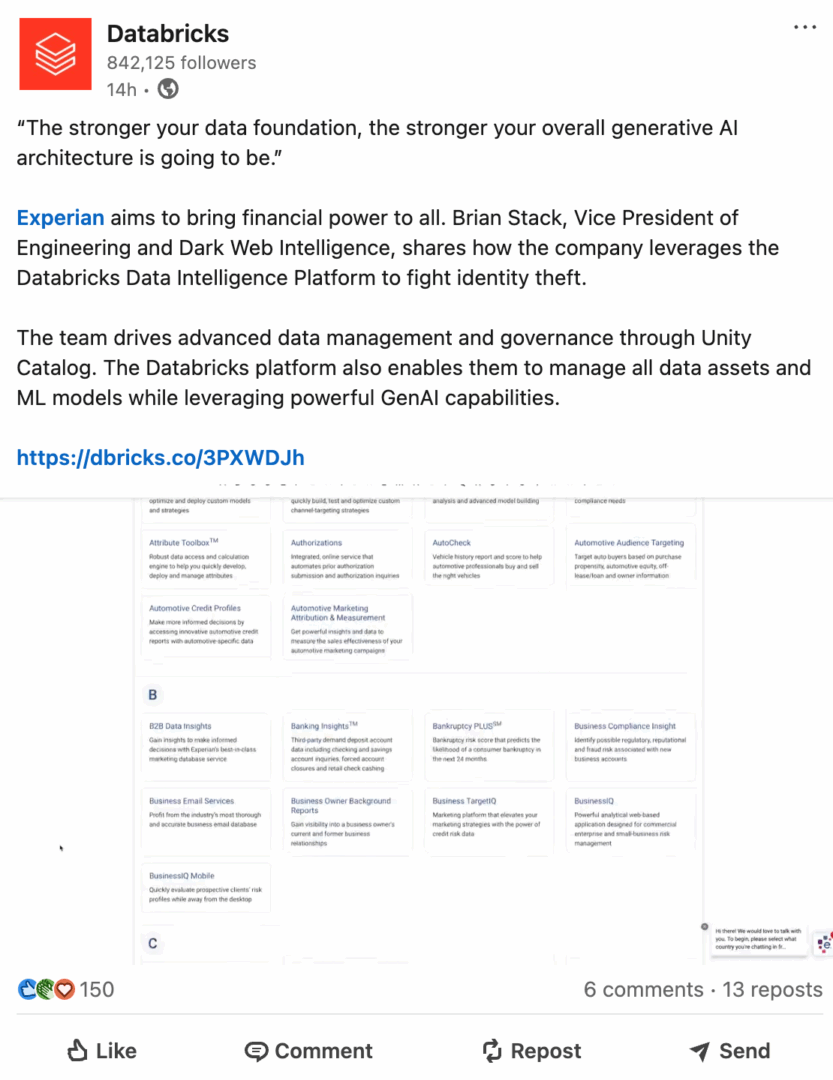
In this post they show how Experian (their client) uses Databricks’ platform. It mentions the customer’s goals (fighting identity theft, bringing financial power to all), the challenges they faced, and how Databricks helped them achieve those goals. In other words, they are saying what the value and benefits of Databricks’ platform are. And even tough the post provides some educational information, its purpose is marketing.
2. Educational content
Many companies, particularly in technology, use a content marketing strategy built around different pillars. One of the most common and effective ones is educational content. This pillar focuses on providing valuable information, insights, and how-to guides to help their target audience learn and improve their skills.
For this pillar, their content takes different forms (blog and audio). They have a YouTube series called “Data Brew” (with 38 episodes and counting) where they “explore topics in the data and AI community”, with an emphasis on data engineering and data science. In this series, they invite AI/Data professionals as guests. We see they use CTAs here, such as “Watch here”.

Under this “umbrella,” we can also include interviews (with a touch of promotional content), where C-suite executives are invited to discuss specific topics. In this example, we have the Databricks CRO. While the post doesn’t directly share deep insights, the quote itself “A good salesperson will teach your customers how to get value out of your product” hints at a broader philosophy about sales. It suggests that Databricks prioritizes value-driven selling, which can be seen as a thought leadership element, even though the full discussion is accessible only through the link.
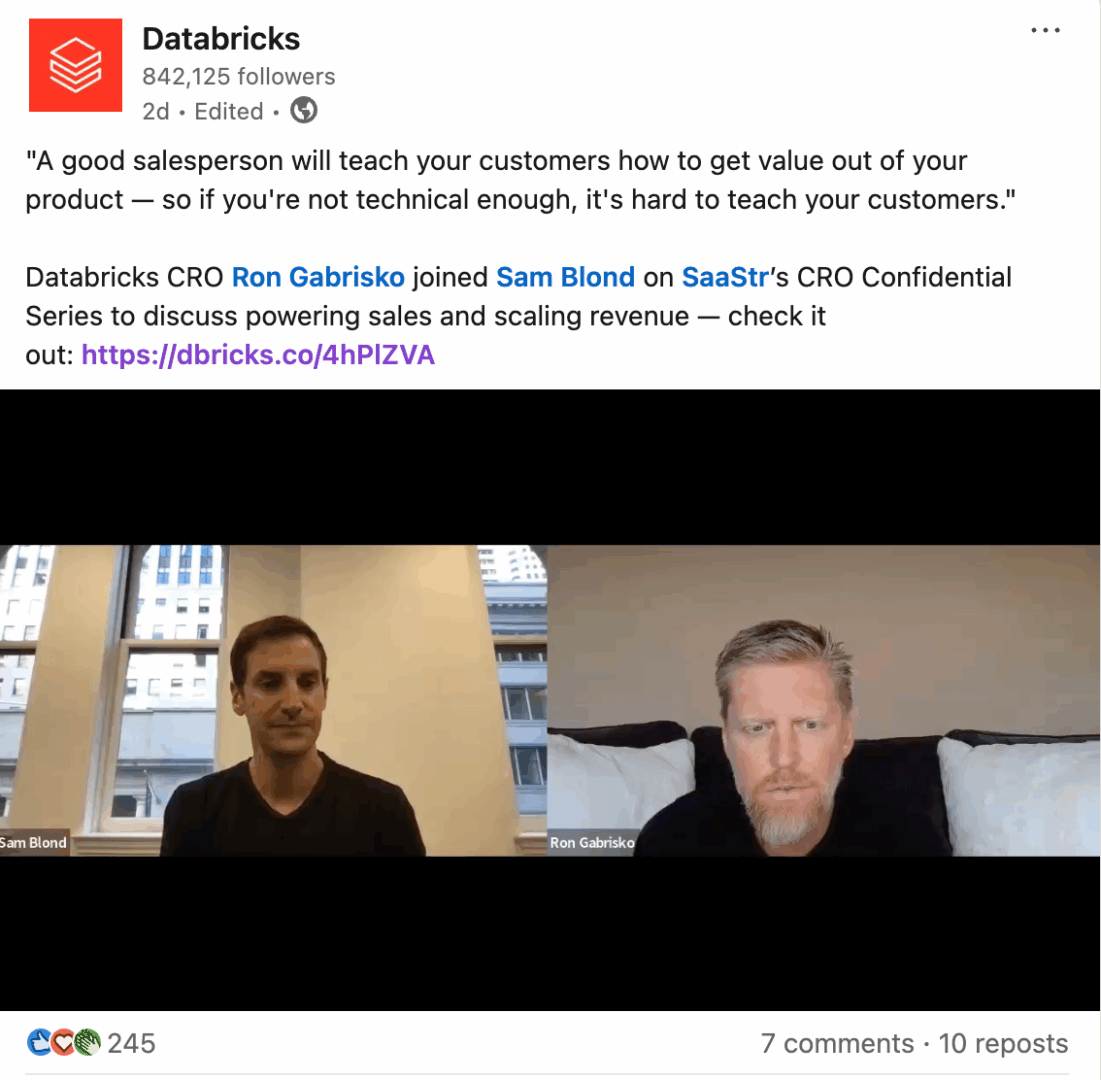
Of course, this content could not be complete without their blog posts, which we will analyze later on.
LinkedIn is used for promoting their blog content.
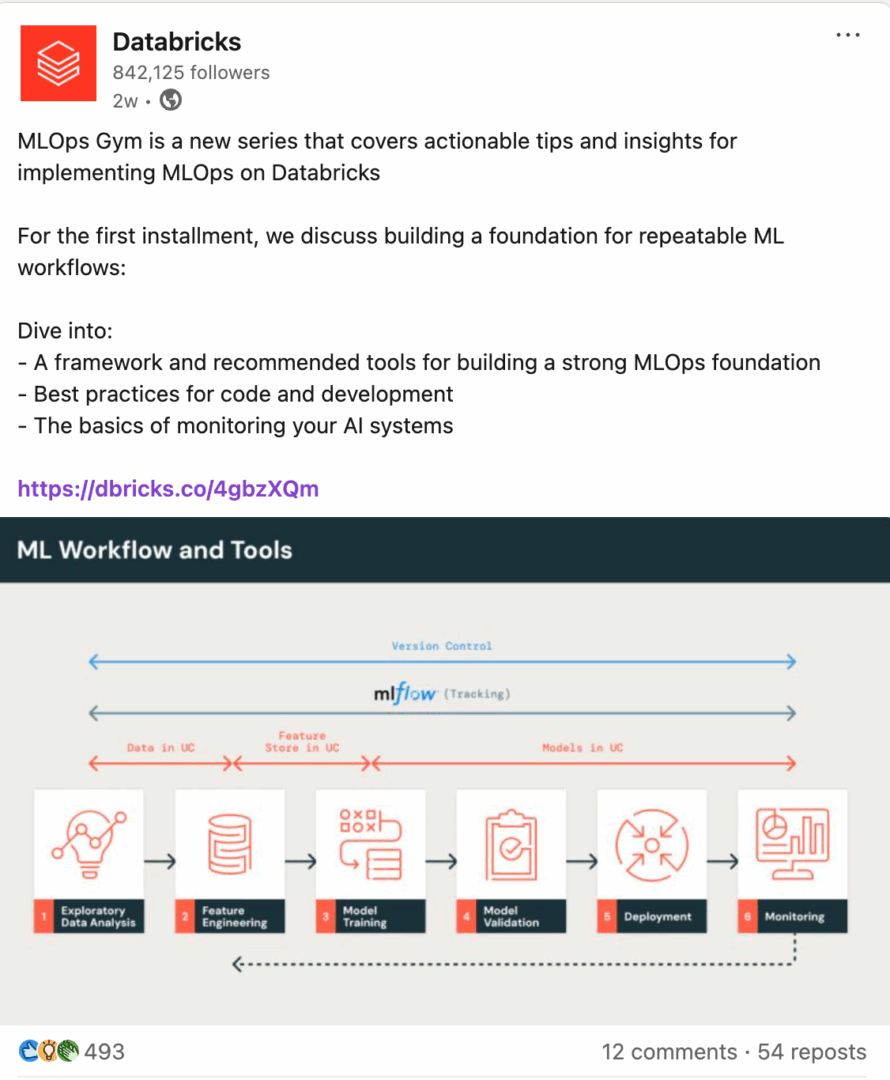
Notice that they use phrases like “actionable tips”, “strong foundation”, “best practices”, and “repeatable workflows”, which attract the audience and emphasize the practical value of the content. While they don’t use a direct “click here” CTA, the post itself serves as one. The link provided naturally directs readers to the blog post.
They also do webinars.
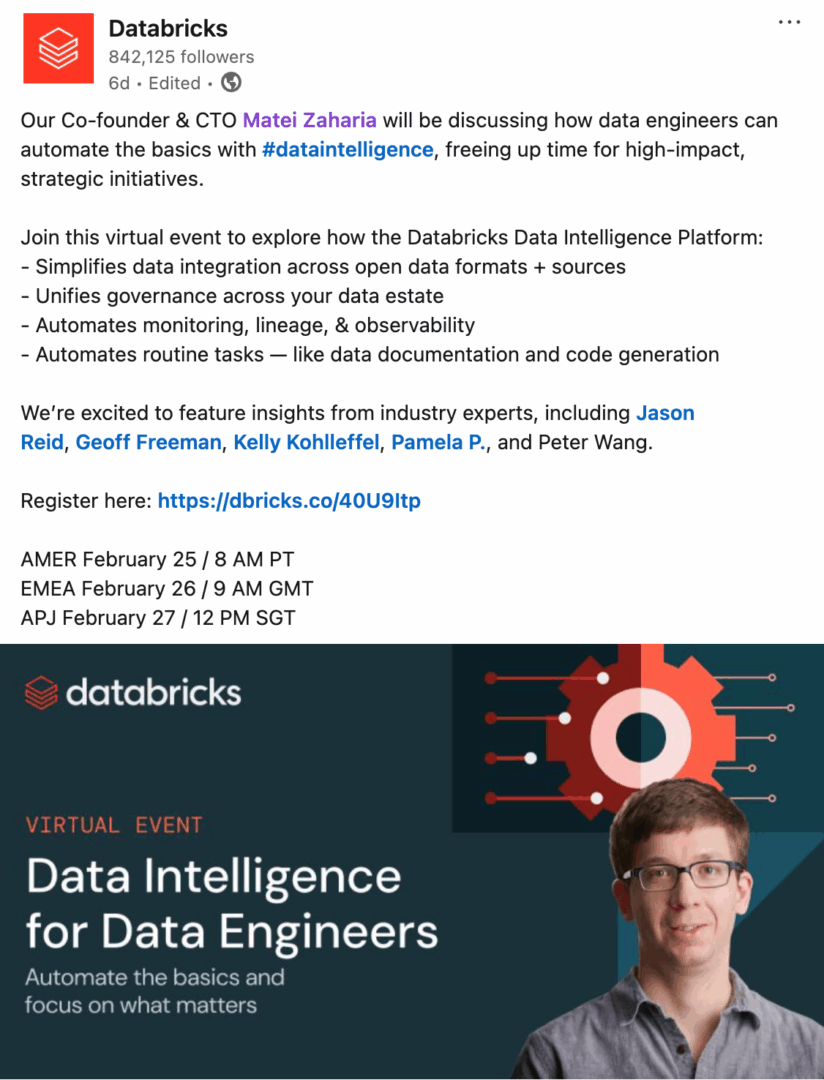
3. Company updates & product announcements
This pillar focuses on feature releases. The posts are structured to inform, promote, and drive traffic through CTAs, and target a specific audience, mostly data engineers or C-level executives.
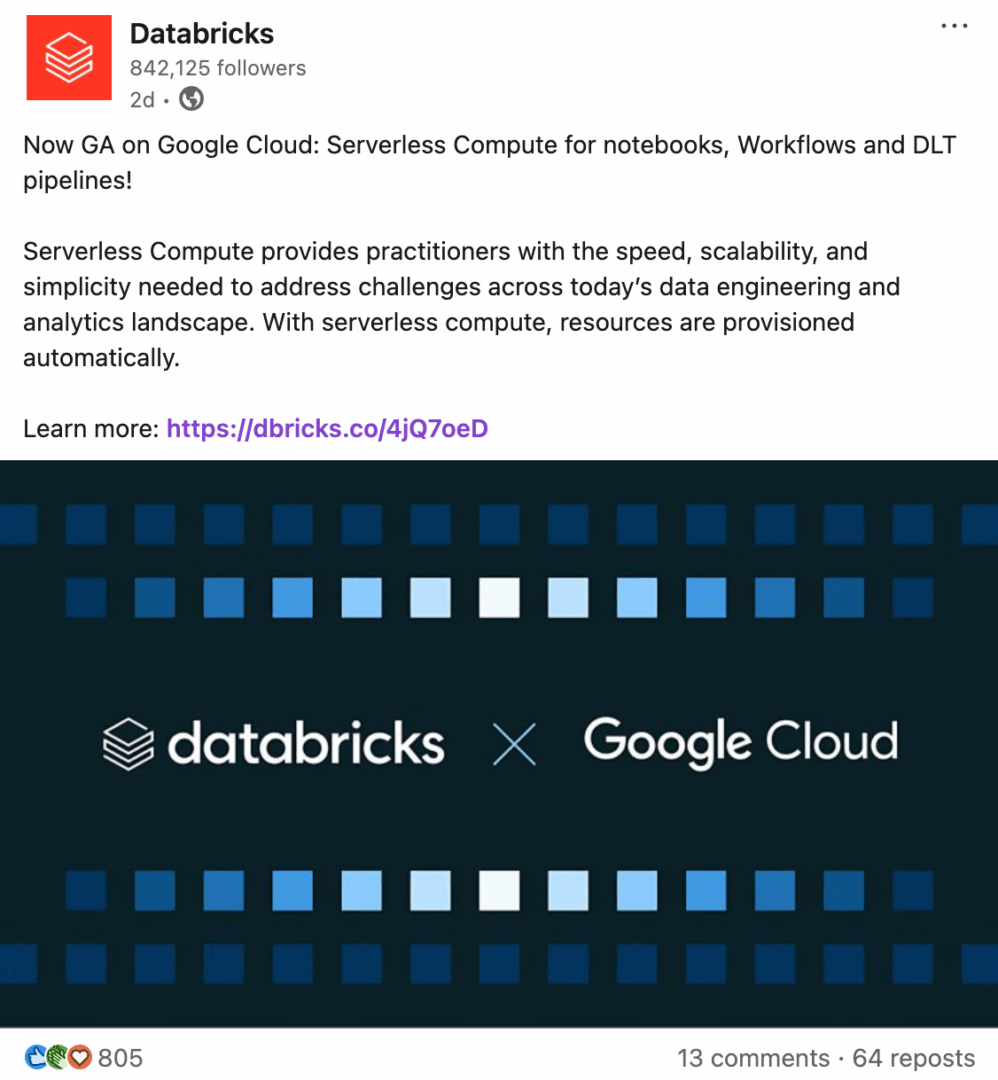
The main message is about Serverless Compute for Notebooks, Workflows, and Pipelines being available on Google Cloud.
The link provided directs leads to their blog page, where they can find more information on that.

This post is primarily promoting the release of a product feature (Databricks Clean Rooms).
4. Partnerships announcement
This pillar is used for announcing collaborations between Databricks and other companies. However, they not only announce the collaboration, they also explain the outcome and purpose of the partnership.
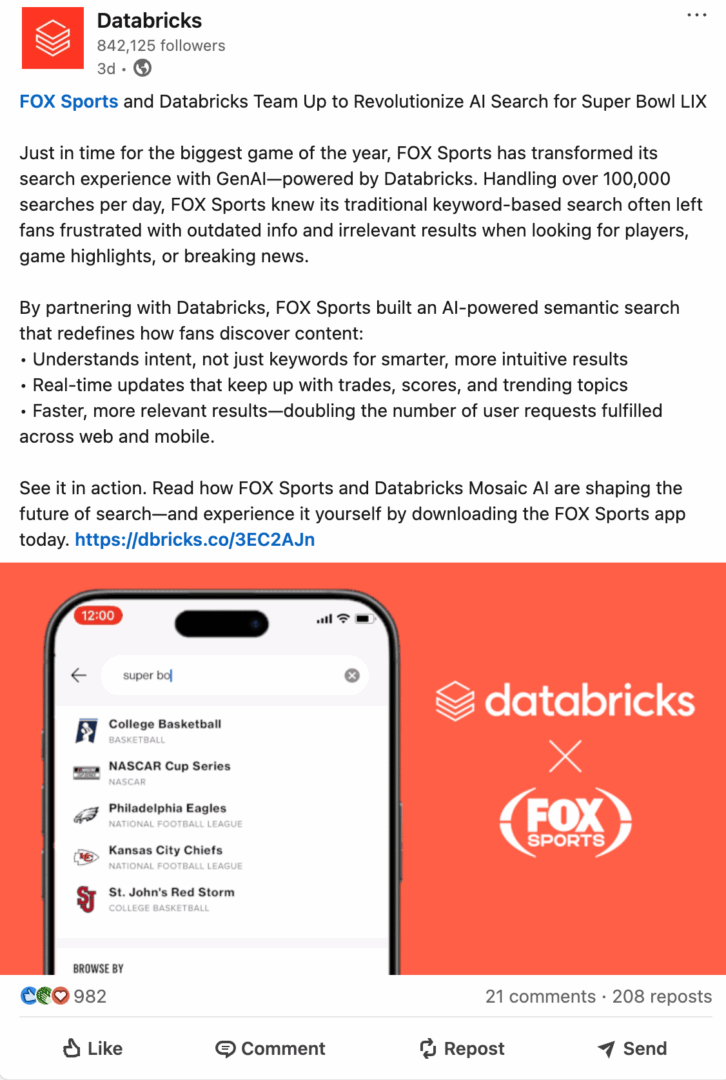
It shows how FOX Sports used Databricks’ technology (specifically Mosaic AI) to solve a real-world problem (outdated and irrelevant search results). While the story focuses on FOX Sports, it ultimately promotes Databricks’ Mosaic AI and its capabilities. The post shows the AI-powered semantic search, real-time updates, and faster results, all features of the Databricks platform.
5. Training courses promotion
This is an interesting one. This pillar’s purpose is to promote a self-paced training course on SQL Analytics and BI on Databricks, offering valuable educational content to users.
The opening line is also on point. The post starts by highlighting a common challenge: the increasing demand for data literacy as organizations democratize data. This makes the training offering relevant and appealing to the target audience.

The most direct reason is to attract more Databricks users. By offering free or low-cost training, they lower the barrier to entry. People who learn Databricks through these courses are much more likely to use it in their work, leading to an increased customer base and revenue for Databricks.
6. Case Studies / Customer Success Story
We see that Databricks is promoting their case studies on LinkedIn. The “Learn more” link directs interested users to more information about Databricks Mosaic AI, driving traffic to their website and generating leads.
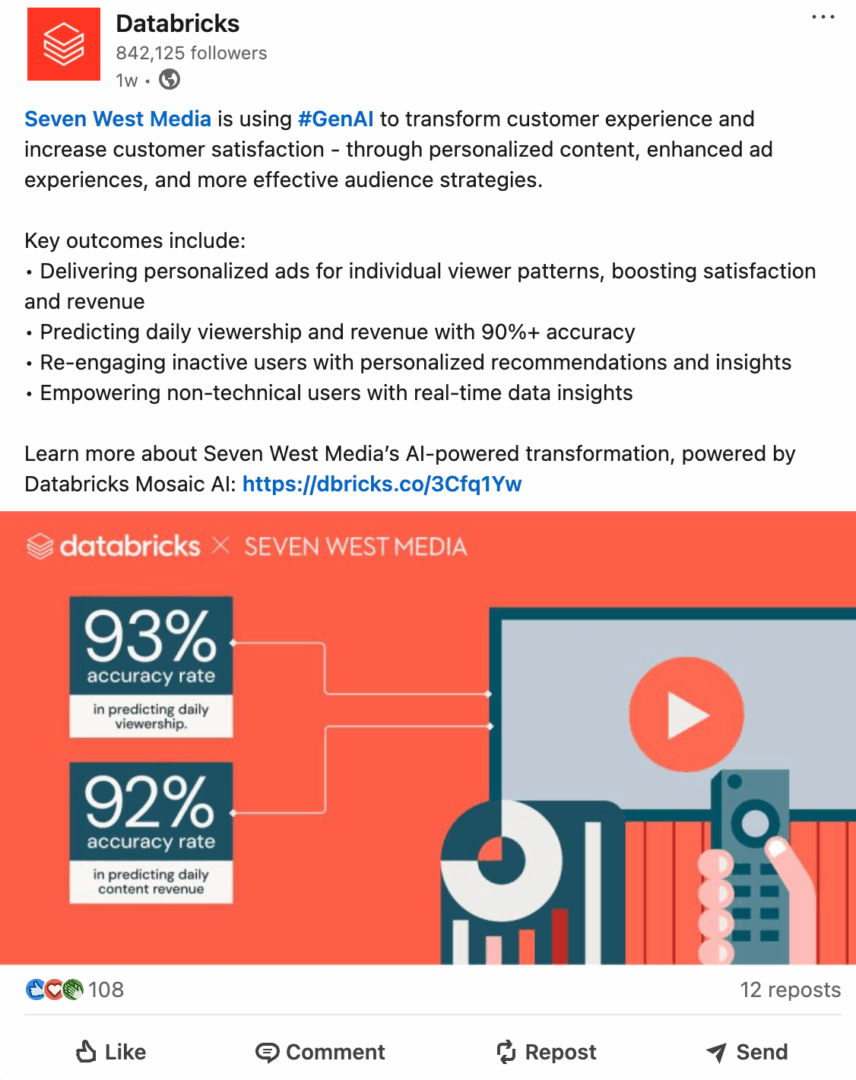
7. Thought leadership
For this pillar, they post interviews with C-level executives or share industry reports. In the example below, the Databricks report focuses on “building and deploying AI to achieve tangible, real-world outcomes.” The idea behind it? To position Databricks as a company that understands the practical application of AI in business. This reinforces their expertise and thought leadership in the AI space. Their collaboration with the World Economic Forum (WEF) further elevates this aspect. Here are some marketing tactics they use: Mentioning #WEF2025 (and #WEF25) connects the post to a major global event, increasing visibility and relevance. The post emphasizes “tangible, real-world outcomes,” which resonates with businesses looking for practical AI solutions. Highlighting well-known customer names provides social proof and builds trust.

Overall goals on LinkedIn
- Make sure Databricks is top-of-mind for organizations looking for data and AI solutions.
- Send prospects to their website (using CTAs + links) and move them through the sales funnel.
- Encourage the use of the Databricks platform. This is done by showing their capabilities and benefits (case studies, educational content, etc.).
- To position Databricks as a trusted expert and innovator in the data and AI space through thought leadership (blog content, reports, interviews).

Databricks has approximately 37,000 followers on Facebook. A quick look reveals many posts that are also shared on their LinkedIn page. While they don’t replicate every LinkedIn post on Facebook, there’s significant overlap.
Maybe this one looks familiar:
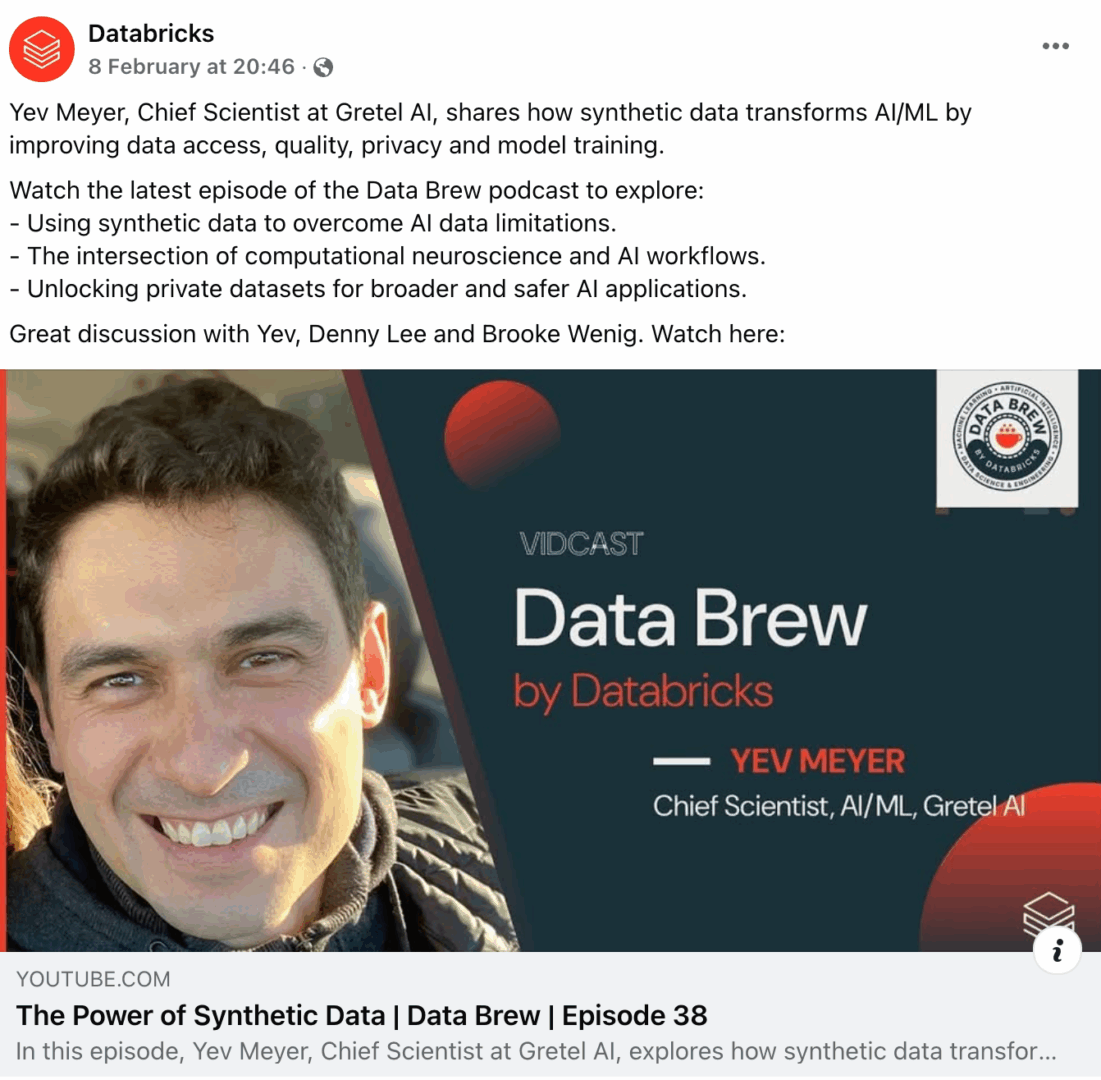
For example, they often use the same descriptions and visuals across platforms. However, their Facebook posting schedule appears somewhat inconsistent. In January 2025, for instance, they posted only once. Engagement on Facebook is also relatively low, rarely exceeding 5 reactions per post.

This channel is not mentioned on their webpage, even though they post quite often here. On Instagram Databricks has almost 43K followers.
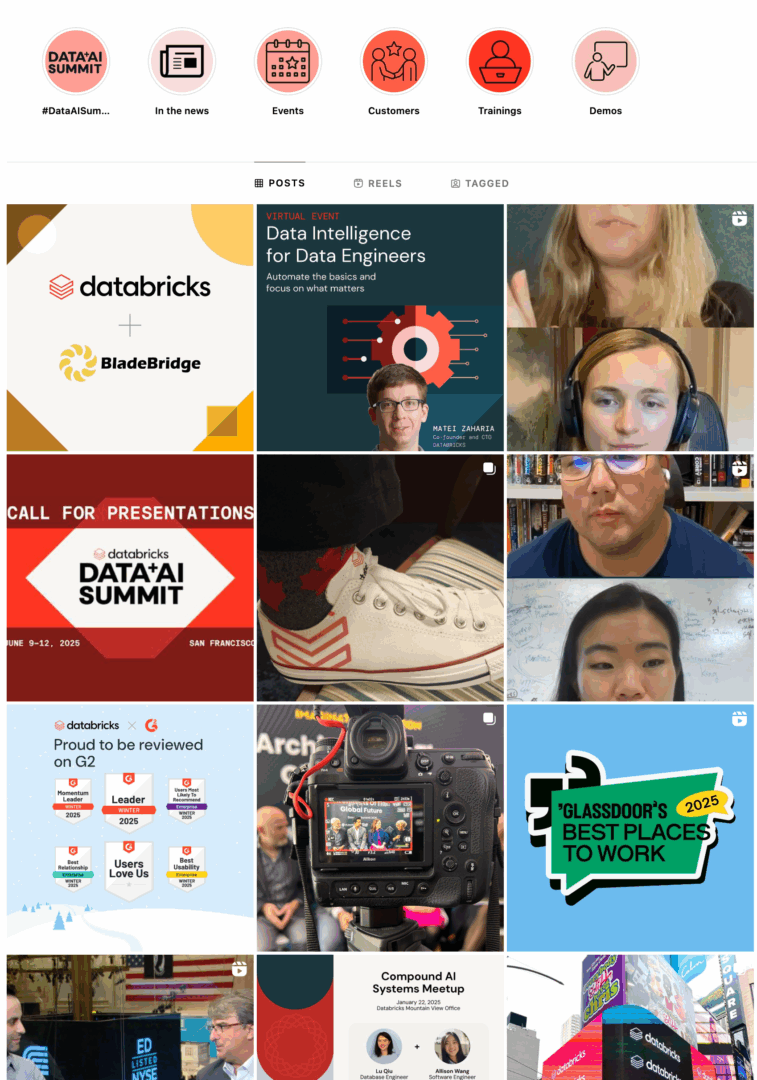
We couldn’t help but notice there are some negative comments about serious misconduct. These comments can seriously damage a company’s reputation. This is a public image crisis, which can be managed by the PR team, in a timely manner. The problem nowdays with social media scandals is that they can escalate to the press, television and of course, damage the ongoing and future partnerships.
We recognize some posts from LinkedIn, but most of them are Instagram specific.
In terms of frequency, they post around five times a week. We also notice that Instagram has a more relaxed tone-of-voice. For example, we noticed an interesting way of promoting their services. They sometimes add…an interesting image. This time it was their own merch (a pair of shoes with the Databricks logo).

Of course, they are also posting more serious things such as Databricks achievements, for example being recognized in G2’s 2025 Winter Report.

Another content pillar, more pronounced here on Instagram is participation in events. For example, this post summarizes Databricks’ presence at NRF 2025, mentioning specific activities and highlights.
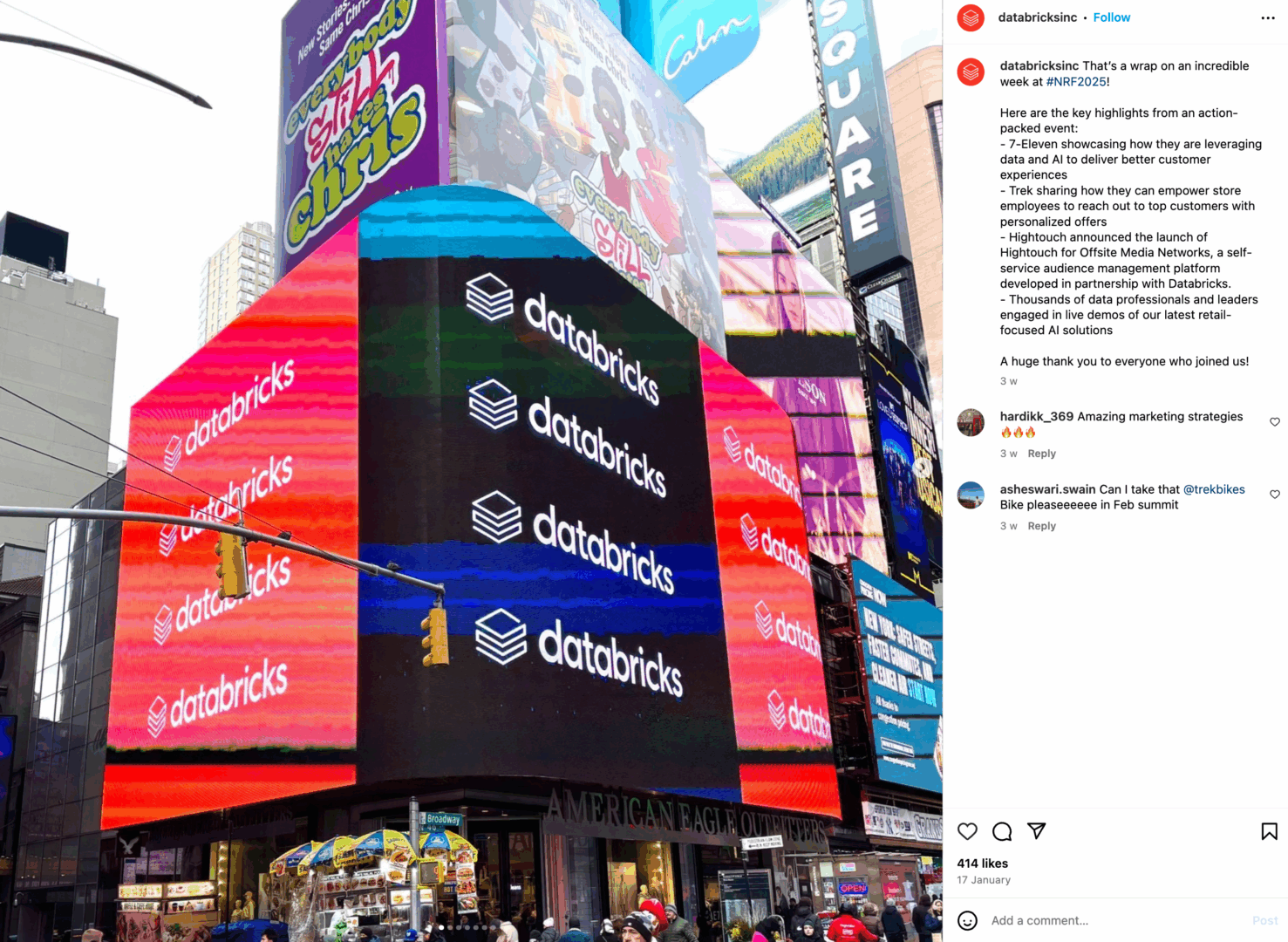
They are also promoting their blog posts.

Engagement on Instagram, while relatively low, is stronger than on Facebook. Most of their posts get around 35 likes, with spikes of ones that reach even over 400 likes.
X
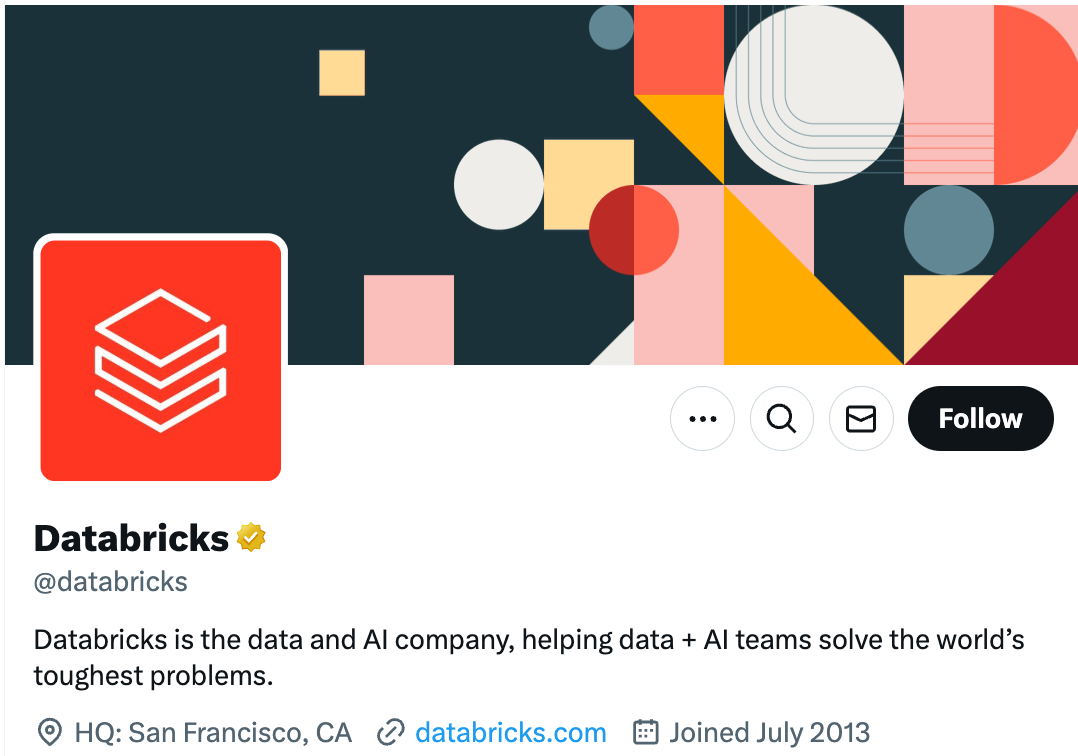
This is Databricks’ second largest platform, after LinkedIn. On X (formerly Twitter) Databricks has 75.7K followers.
A significant portion of their posts focus on announcing new features (Clean Rooms, Dashboard Embedding, BladeBridge integration), highlighting their benefits.

They also use X to promote events like the Data + AI Summit and virtual events featuring their CTO.
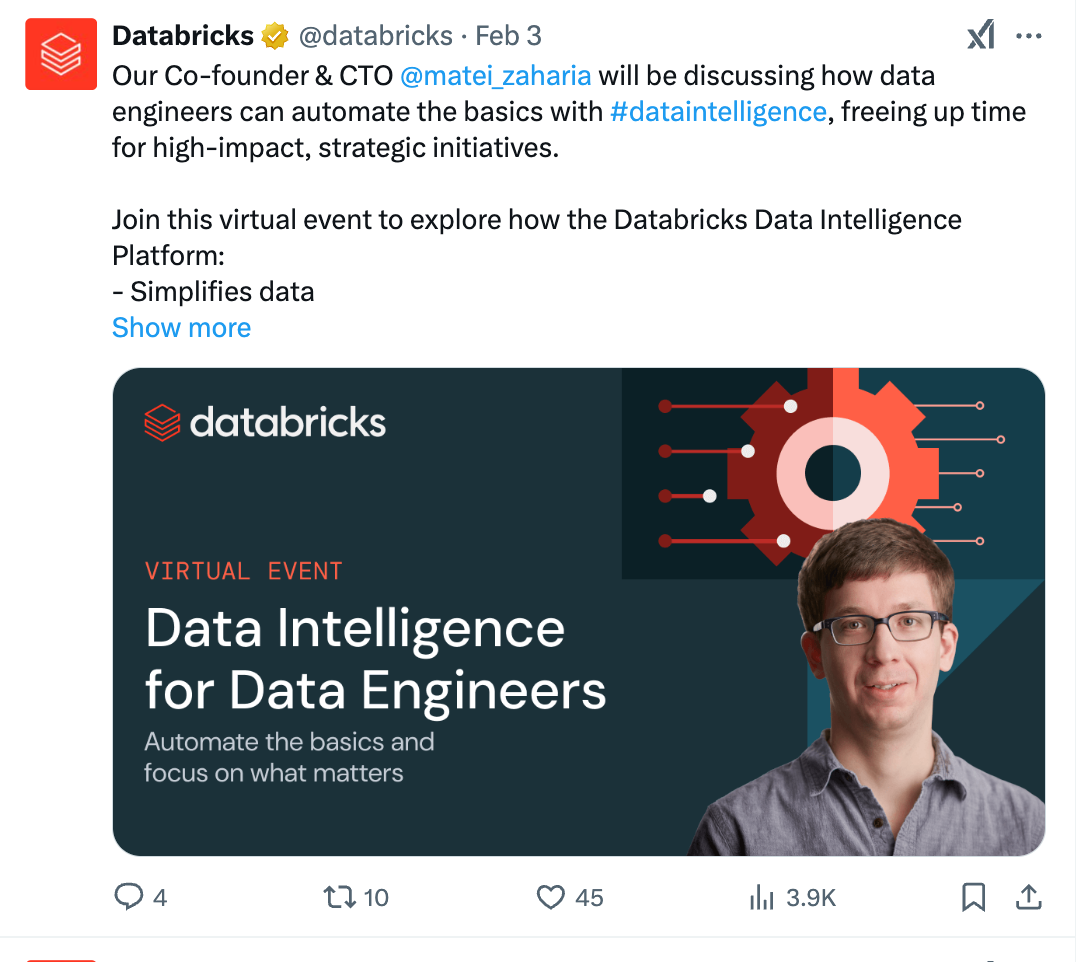
Databricks has a consistent posting schedule, often posting multiple times per day. This keeps them visible in their followers’ feeds.
The tone is generally professional, informative, and enthusiastic. They use positive language (“excited”, “powerful”, “leading companies”) and focus on the benefits of their platform.
CTAs are generally implicit rather than explicit. They often include links to learn more, register for events, or read blog posts. So, they don’t always say “click here”. Apparently, they prefer a more subtle approach.
While their reach is good (2K–6K), the engagement (likes, reposts, and replies) could be higher. They could consider experimenting with more interactive content, polls, or questions to encourage more direct engagement.
YouTube
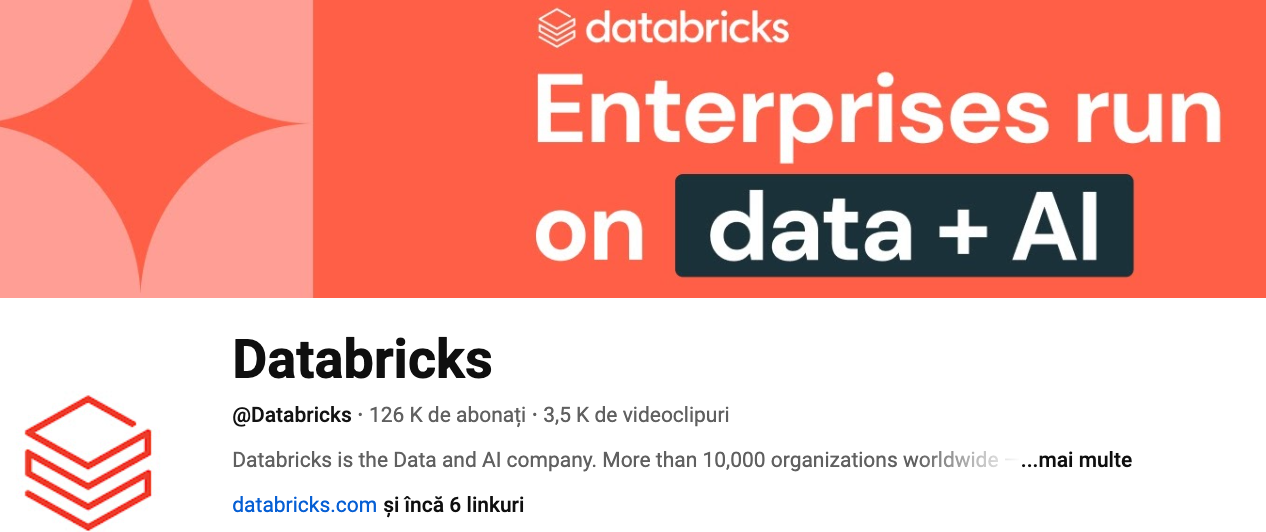
Now, let’s look at YouTube. There’s a lot happening here.
They have 126K subscribers and 3.5K posted videos. For a company, Databricks has a really good reach. Also, as you can see, they have many content pillars and videos. This demonstrates an investment in video marketing and suggests a long-term strategy. The videos are professionally produced, with a consistent visual identity and a clear message.

Some of their content pillars:
- Customer Series: Data + AI in Action
- Data + AI Executive Serie
- Databricks Demos
- Databricks SQL
- Data Governance
- Getting Started with Databricks
The length of their videos varies. For example, in the Customer Series pillar, they use short videos (under two minutes) to show how prominent companies (Virgin Australia, Bayer, Virtue Foundation, etc.) use the Databricks platform to improve their operations.
YouTube is also used to promote events such as the “Data + AI World Tour”, offering a preview of the event and encouraging users to register.
On YouTube, they post weekly. In terms of reach, some videos have around 3K views, some more, and some just a few hundred.
Most videos include links to the Databricks website, blog, and other social media platforms, directing users to more information and interaction opportunities.

Social Media Strategy Analysis
What we can say for sure is that Databricks takes great care of their content. It’s not easy to post so often. But posting frequently also means that the company is quite active in creating blog content to be shared, pitching stories, and generating leads (used for creating customer testimonials). All that effort isn’t just about the content itself, though. It also builds them up as thought leaders, especially through their videos.
Their marketing activities are well-defined and strong, which is why they have such a huge reach and number of followers, both on LinkedIn and YouTube. But especially on Youtube (which, in our opinion, is something to be proud of). People do not necessarily go on YouTube to watch companies, because it’s not their usual background playlist. Yet Databricks manages to attract interest through diverse content pillars and topics.
In terms of lead generation, they seem to follow some strategies, such as:
- Showing how their platform has helped other businesses achieve specific results builds trust and encourages potential customers to learn more.
- Promoting webinars, conferences (like the Data + AI Summit), and virtual events.
- Offering training courses.
LinkedIn is also used for demand generation, with a focus on content marketing, namely for sharing industry insights, reports, and C-level interviews.
Your LinkedIn strategy should be built on different content pillars, explaining What you can do? Share customer success stories, offering valuable educational content, announcing product updates, highlighting key partnerships, and show thought leadership.
Every piece of content you create should offer real value; something leads can take away and think, “Hey, that’s useful! I can apply this to my strategy/content/business plan.” It shouldn’t feel like just another sales pitch.
But the most important thing? Always focus on solving real problems. Every piece of content should answer this core question: “How does this help our potential customers?”
And don’t forget the power of your leadership’s personal brand. When executives like Ali Ghodsi share authentic, insightful content, it humanizes your brand. People naturally connect and trust other people, and content shared by recognized leaders carries more weight. They’re seen as experts, and their insights build trust in the company and brand.
Whether you’re a B2B SaaS startup or a large enterprise, a strategic social media presence can give you a real competitive edge. So, let’s not just market. Let’s connect, educate, and inspire.
Demand generation
In this section, we focus on analyzing demand generation efforts, particularly content marketing. Let’s begin by examining the blog page.
Blog Page
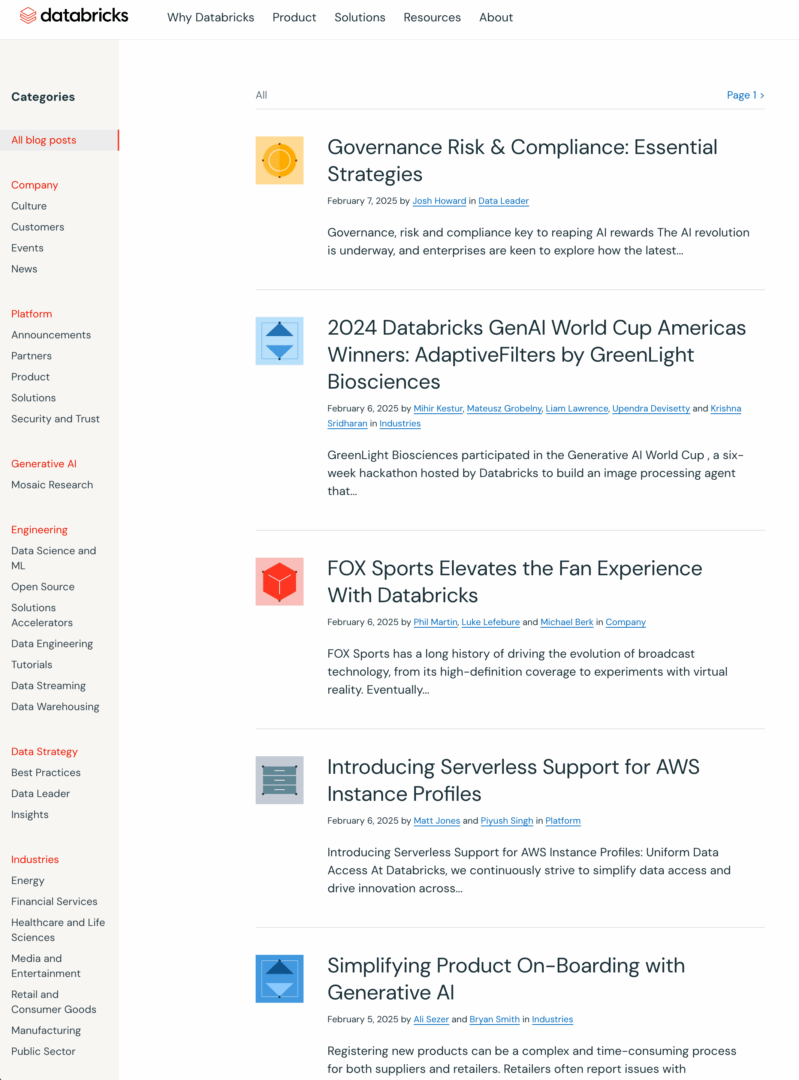
We can see that the blog posts comprise many categories, such as Company, Platform Updates, Generative AI, Engineering, Data Strategy, and Industries.
Some posts, like the introduction of “Serverless Support for AWS Instance Profiles”, discuss technical details and explain how specific features work. This is likely created for a more technical audience (e.g., CTOs).
In terms of posting frequency, they seem to be posting almost daily. We chose the fifth post down the list, and it was “Simplifying Product On-Boarding with Generative AI”. This article is part of the Industries category.
Blog Post Analysis
The blog posts often start with a “Summary”. This can be a good idea if the content allows. The purpose of this summary is to provide a concise overview of the content. This is particularly useful for social media posts, where attention span is short.
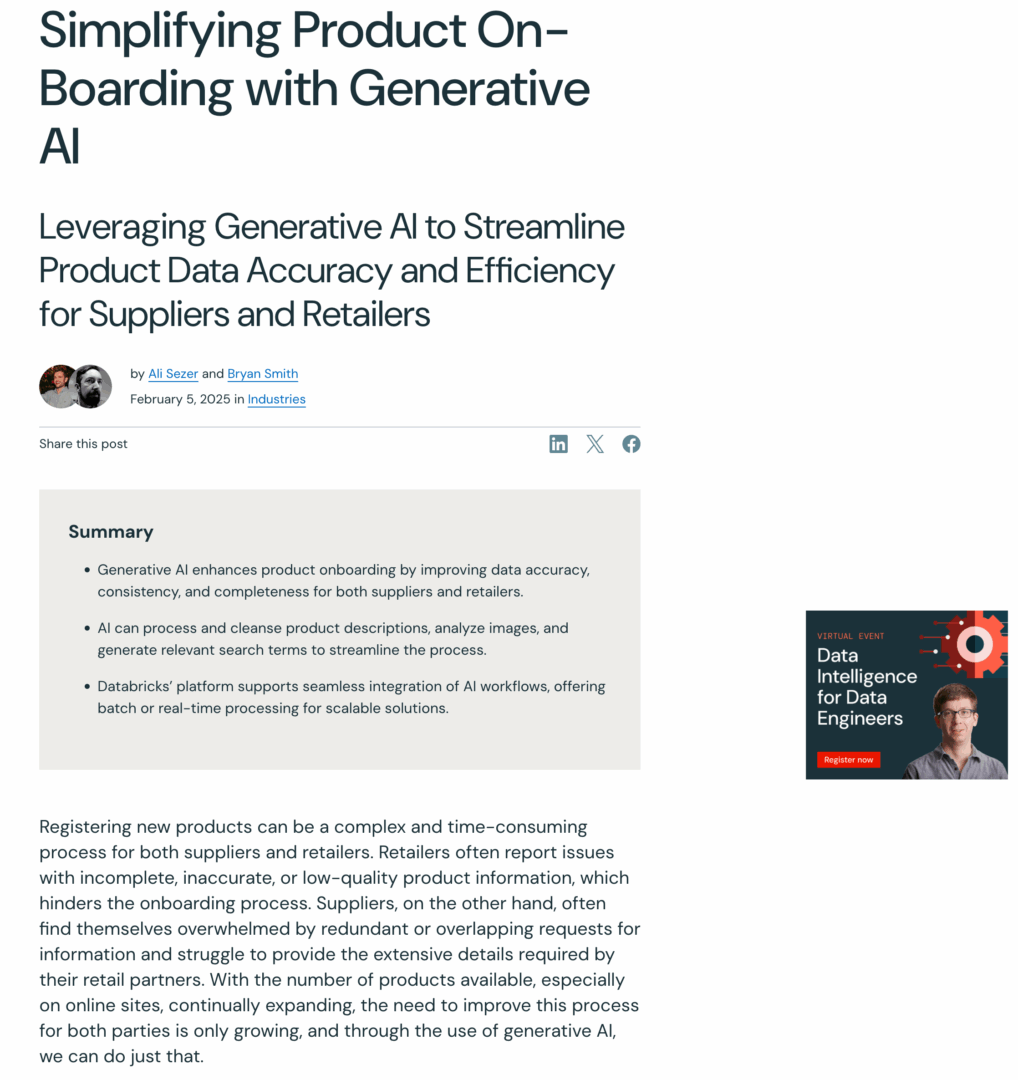
Before analyzing the content, let’s observe the box on the right side of the page. It’s an advertisement for a virtual event called “Data Intelligence for Data Engineers”, designed to promote the event and encourage registration. Why is it placed here? Perhaps the blog has a large readership, and they are trying to expose the webinar wherever the audience might see it.
Now, regarding the content:
- The length of the blog post is around 1400 words.
- They use figures in their content. This is a great idea. Figures can help explain complex concepts more effectively than text alone. For technical or data-heavy topics, charts, infographics, and screenshots can make information more digestible.
- The tone is informative, professional, and solution-oriented. Words like “streamline”, “scalable”, “efficiency”, “challenges”, and “solutions” target a business audience concerned with improving processes.
- The language is generally accessible, although some technical terms are used (e.g., “semantic search,” “vector store”). The overall tone is positive and encouraging, promoting the benefits of Databricks’ platform.
- The post is well-structured, with clear headings and subheadings that make it easy to read and navigate.
- The post includes clear calls to action, encouraging readers to download the solution accelerator and try Databricks for free and “Get Started”. This is a very important element for generating leads.
- The end of the articles in a dedicated to their “sales pitch”.
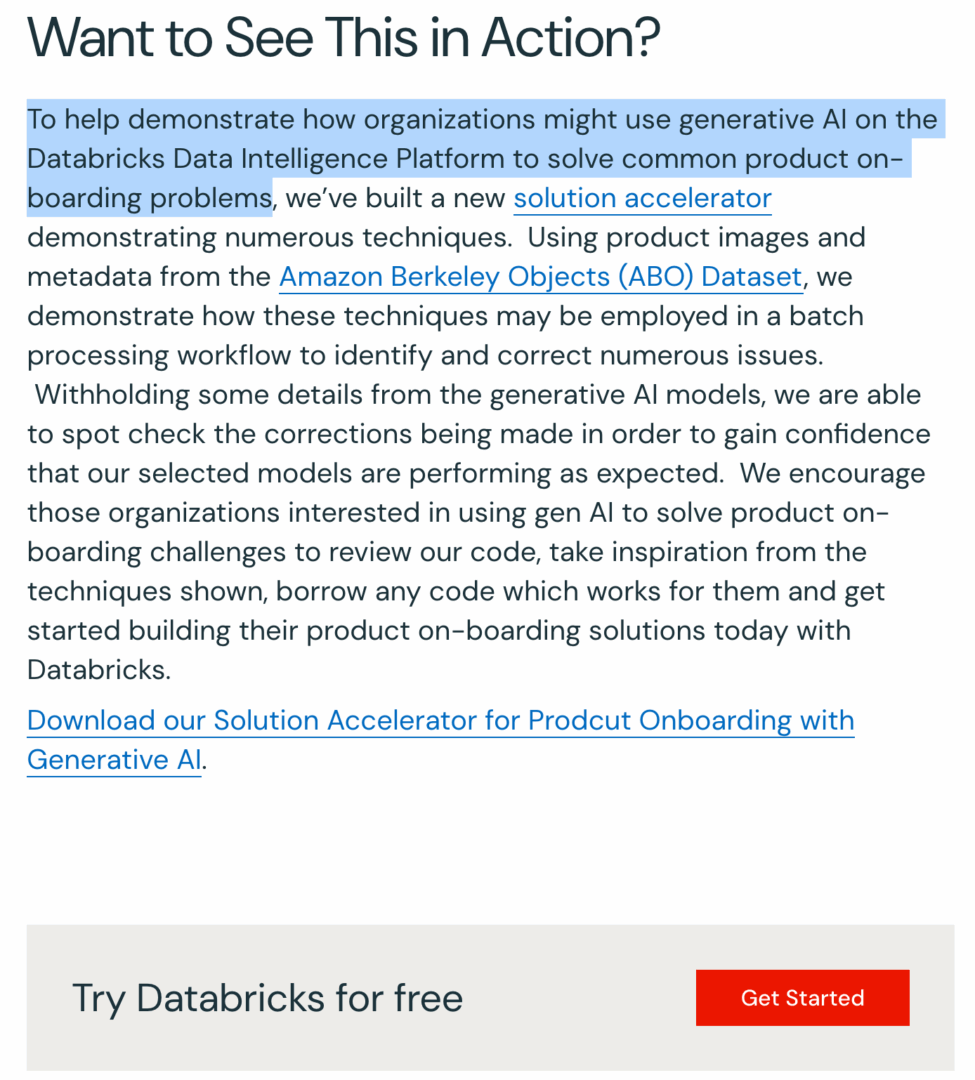
At the bottom of the page, they placed their “Related posts”, where they recommend other articles related to this subject.
Databricks’ Community
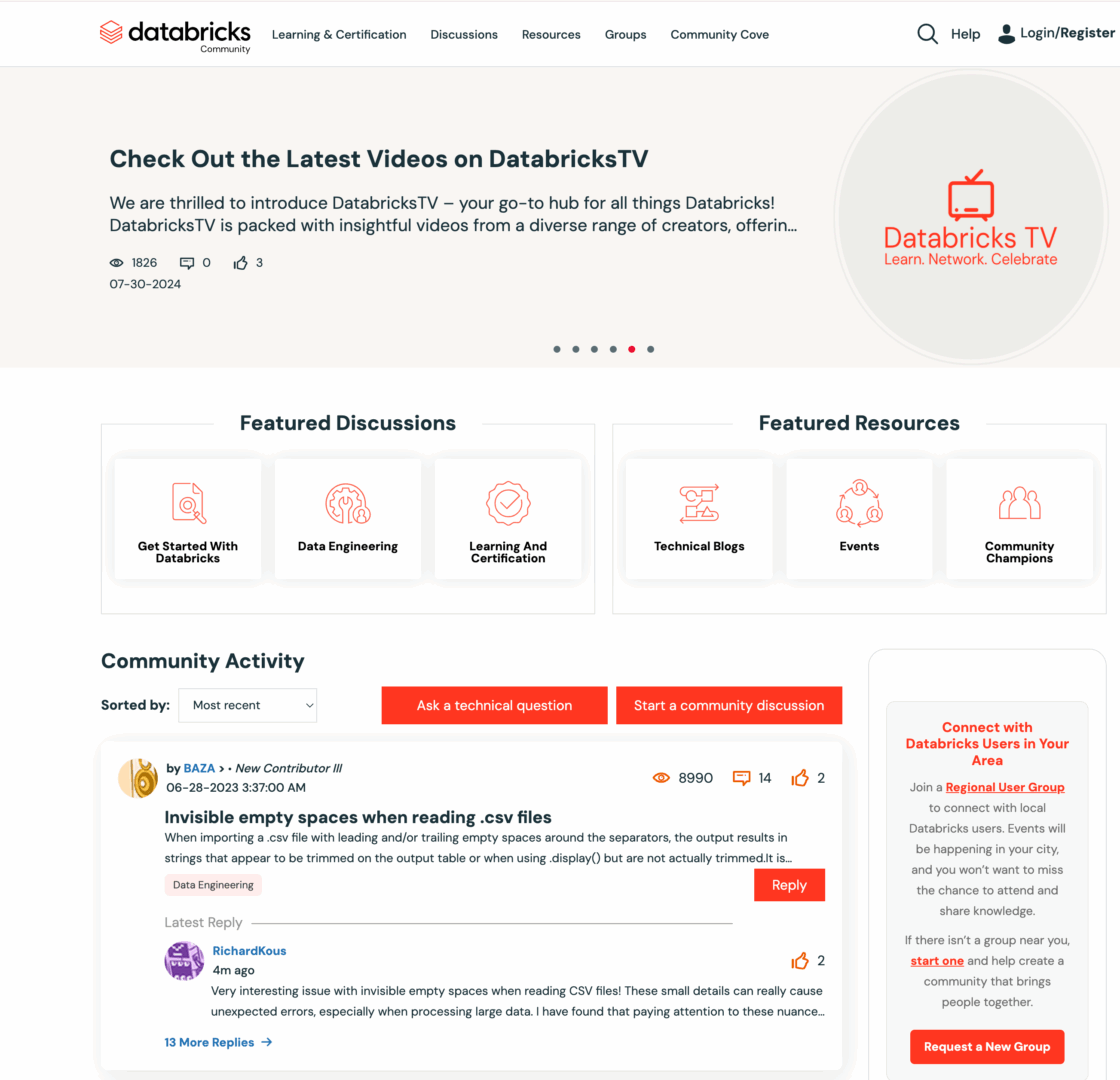
This section allows users to participate in discussions, ask questions, and help others with answers. There’s a lot of activity here. They also have a “Top Kudoed Authors” section.
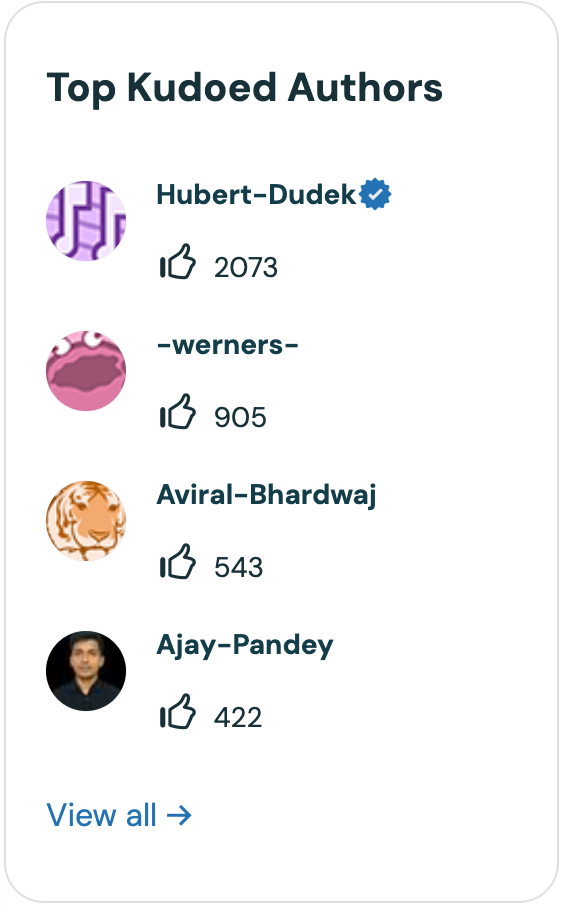
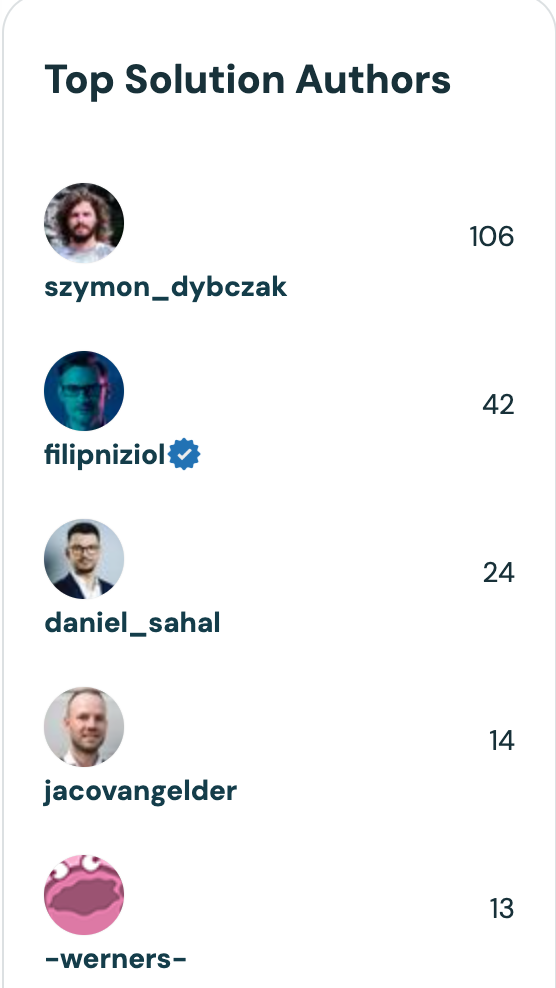
This acknowledges community members who consistently provide valuable contributions, encouraging active participation. This feature incentivizes users to share high-quality content and helpful responses, as they can earn recognition for their efforts.
Community members can choose which “Featured Discussions” they want to participate in.
Interesting to notice, the “Featured Resources” section contains different, more technical information than the general blog accessible from the main page. So, they have a separate, “technical” blog focused on insights in data analytics and machine learning.
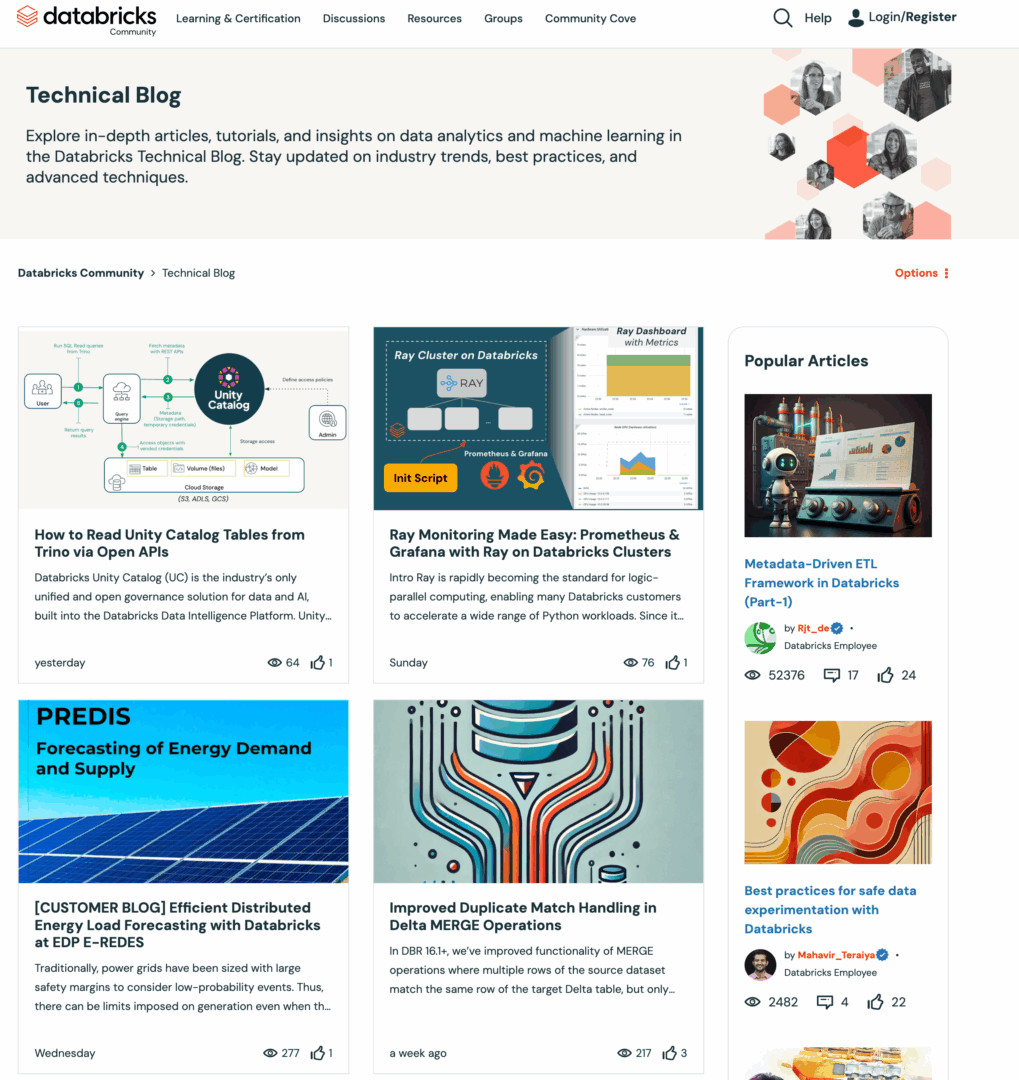
The Databricks technical blog is a valuable resource for the data community. New articles are posted weekly, authored by Databricks employees who contribute their expertise and insider knowledge. These blog posts are highly technical and often include code snippets, catering to a specific audience (data engineers and data scientists). There are no CTAs at the end of the articles.
The blog covers a wide range of topics, including:
- Detailed tutorials on using Databricks features and tools
- Best practices for data engineering and analytics workflows
- Case studies and real-world applications of Databricks solutions
- Updates on new platform capabilities and integrations
Announcements
In the community section, they also have a dedicated section for announcements where they promote their virtual events, for which you have to sign up. This section keeps users informed about the latest Databricks updates and features. It highlights innovation and progress, which can be important for attracting and retaining customers. It also serves as a platform to announce new offerings or partnerships.
The “Click here to register now!” button sends the lead to the virtual event registration page.
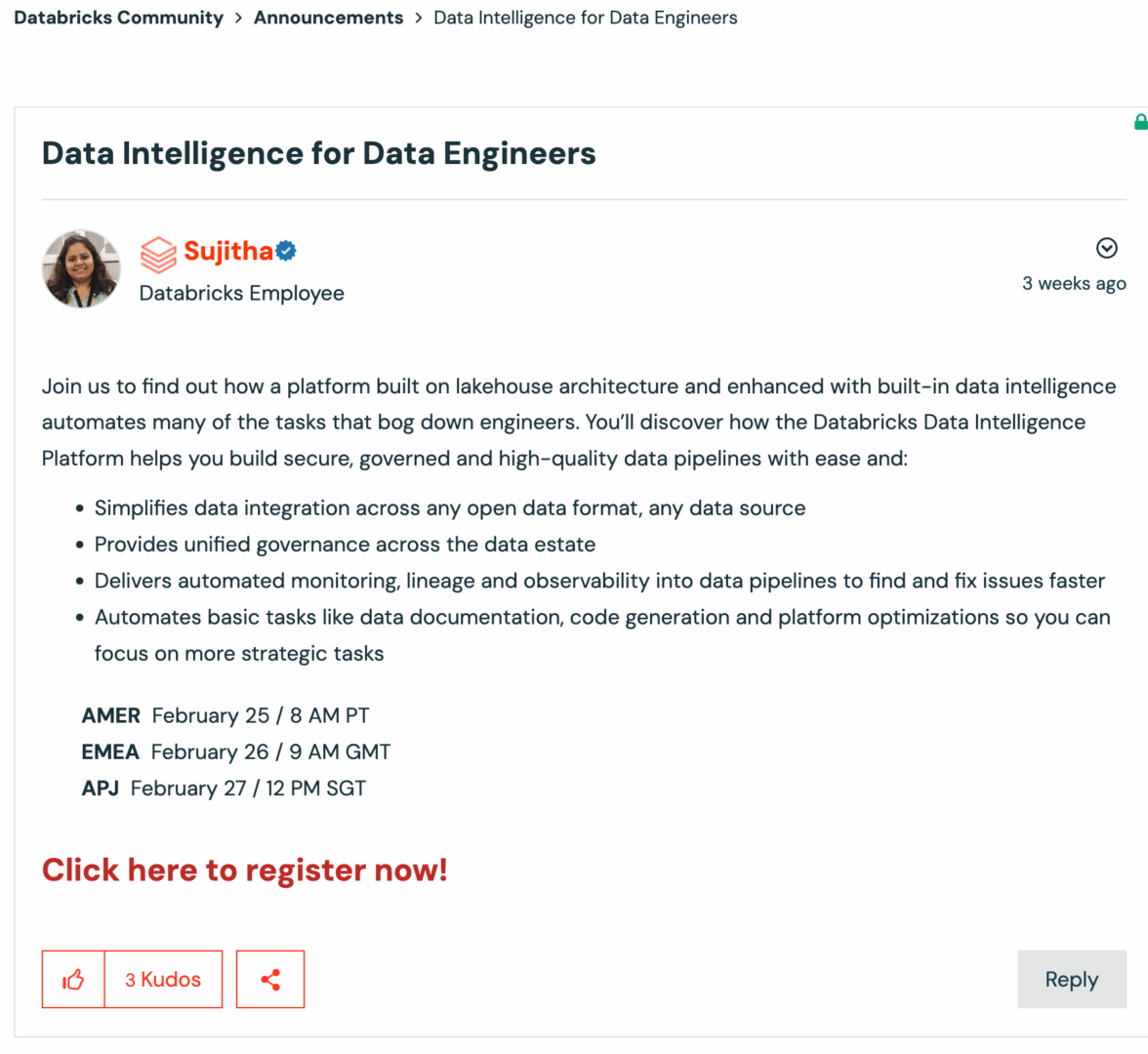
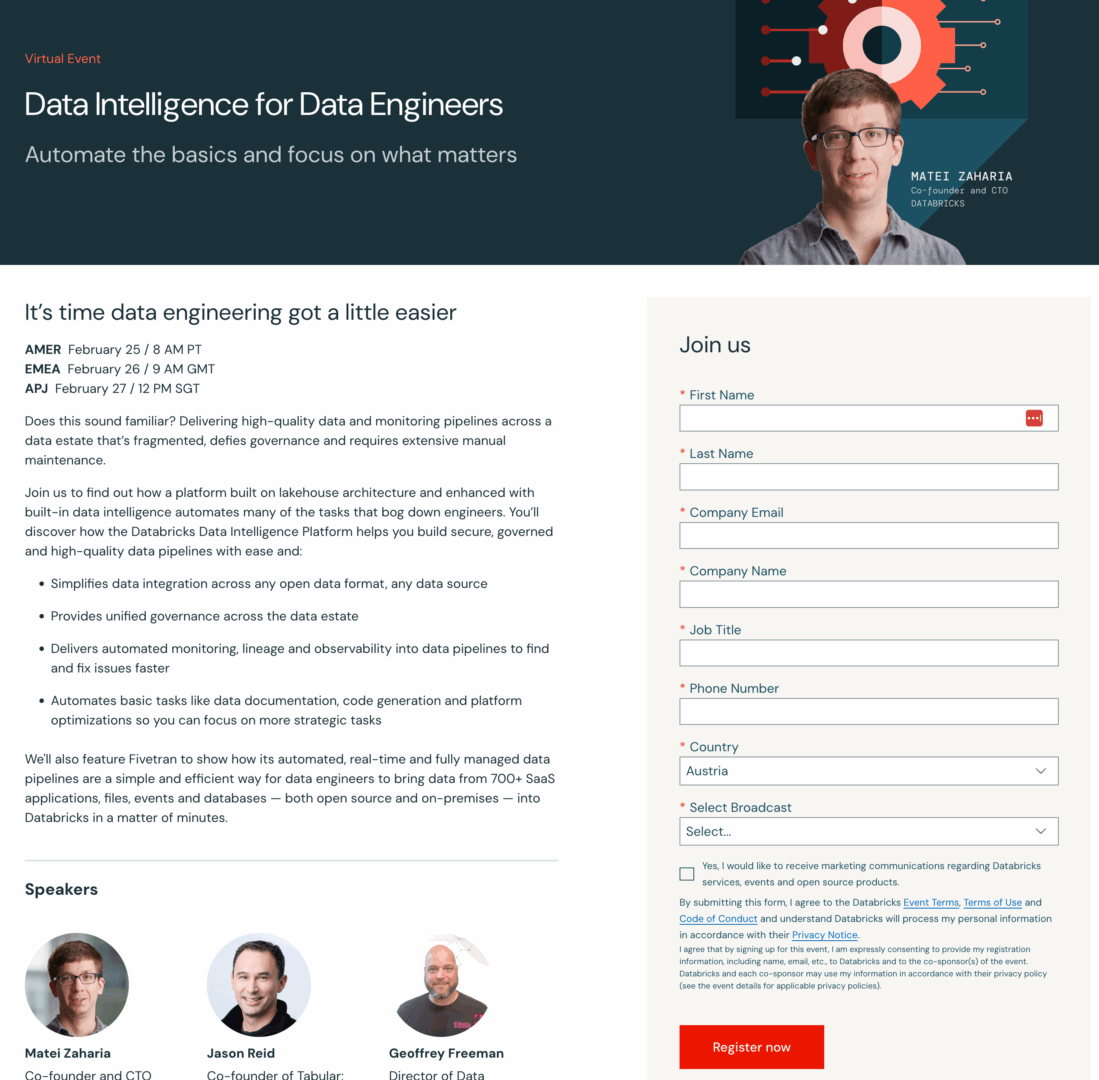
So, whenever they have an event going on, they promote it on multiple pages of their website, especially where the traffic is high.
Community Cove
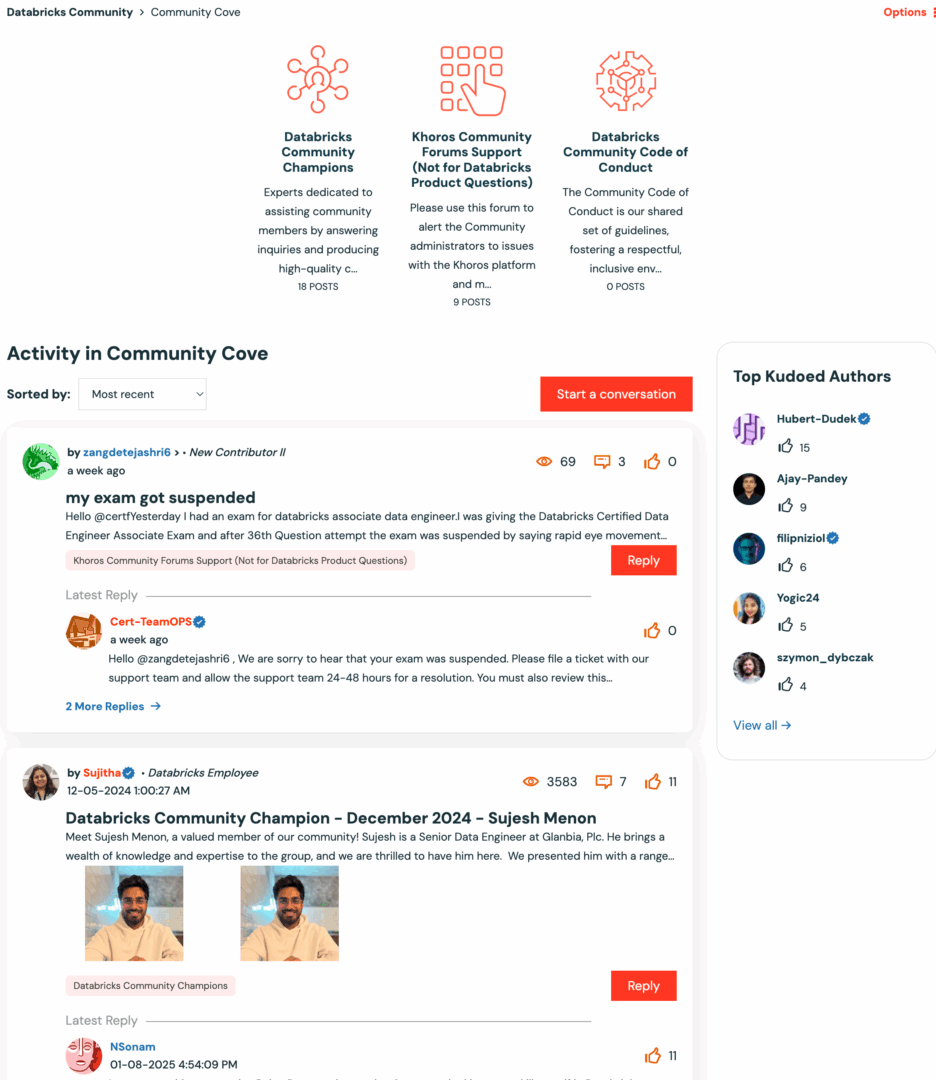
Community Cove is a central hub within the Databricks Community platform designed to create connection, collaboration, and empowerment among Databricks users and enthusiasts.
It serves as a focal point for various community-related activities and resources, including:
- Databricks Community Champions: A group of experts dedicated to assisting community members by answering inquiries and producing high-quality content such as blogs, vlogs, and events.
- Community Platform Discussions: A space where members can connect with fellow users to discuss general topics related to the Databricks platform, industry trends, and best practices.
Community Cove also has:
- Regular updates and announcements, such as the monthly Databricks Community Champion spotlight.
- Opportunities for members to engage in discussions, share knowledge, and seek assistance from peers and experts.
- A platform for showcasing community contributions and recognizing active members.
At the end of the community page, they have a section dedicated to their technical blog, “Latest from our Blog”. This section showcases recent blog posts, driving traffic to the Databricks blog and providing valuable content to potential customers.
Now let’s move on to the Academy section (Training and certification).
Databricks’ Academy
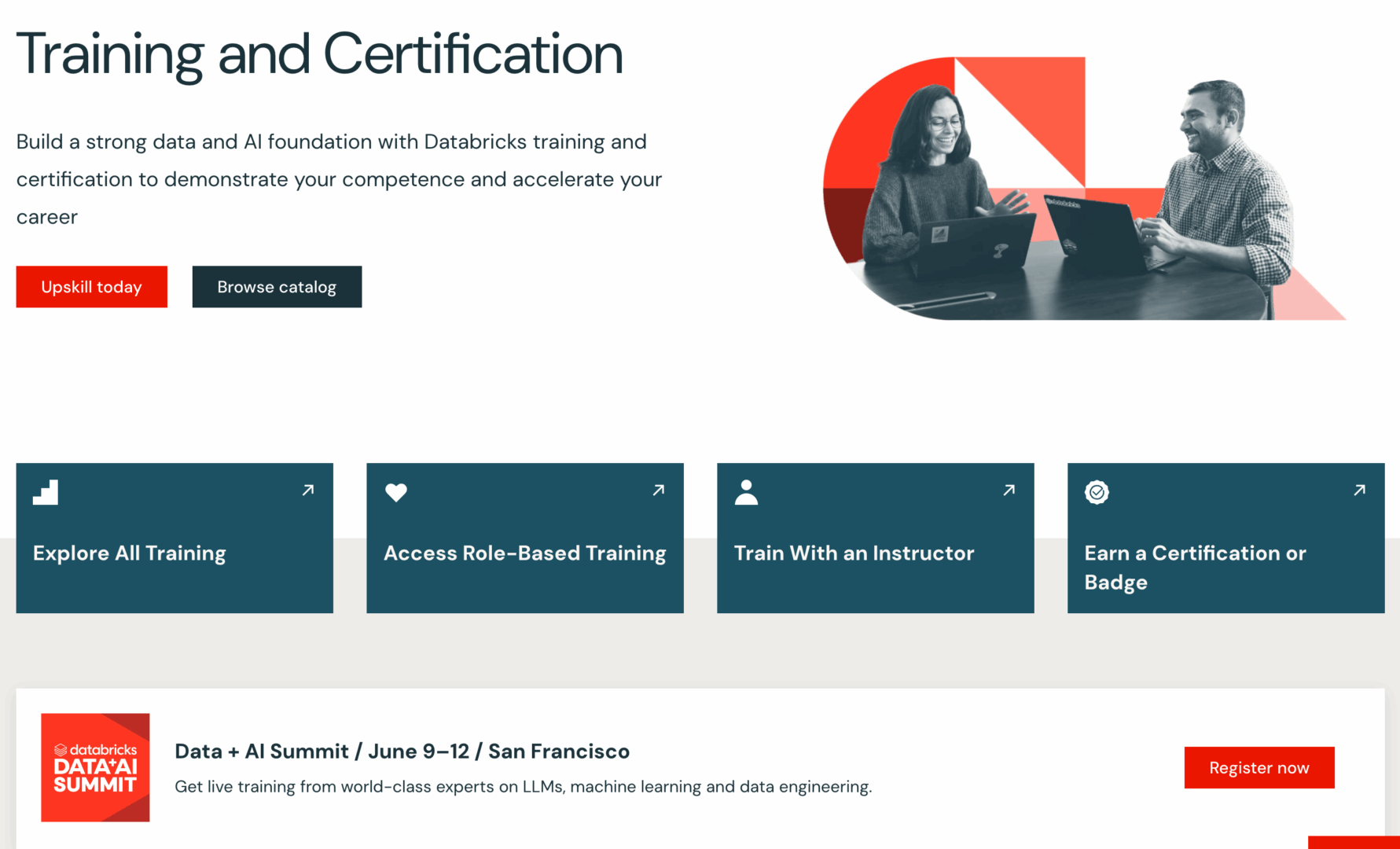
Here, leads can choose to sign up for the Academy (“Upskill today”) or “browse the catalog and pick a course”.
This Academy focuses on understanding and using Databricks through training and certification programs.
Its value proposition is: “Build a strong data and AI foundation with Databricks training and certification to demonstrate your competence and accelerate your career”. This clearly states the benefits of the program, appealing to both individual career growth and organizational needs for skilled professionals.

If you choose a course from the catalog, you will be sent to a page “learning library”. Here you can pick the courses you are interested in. They offer self-paced to instructor-led courses.
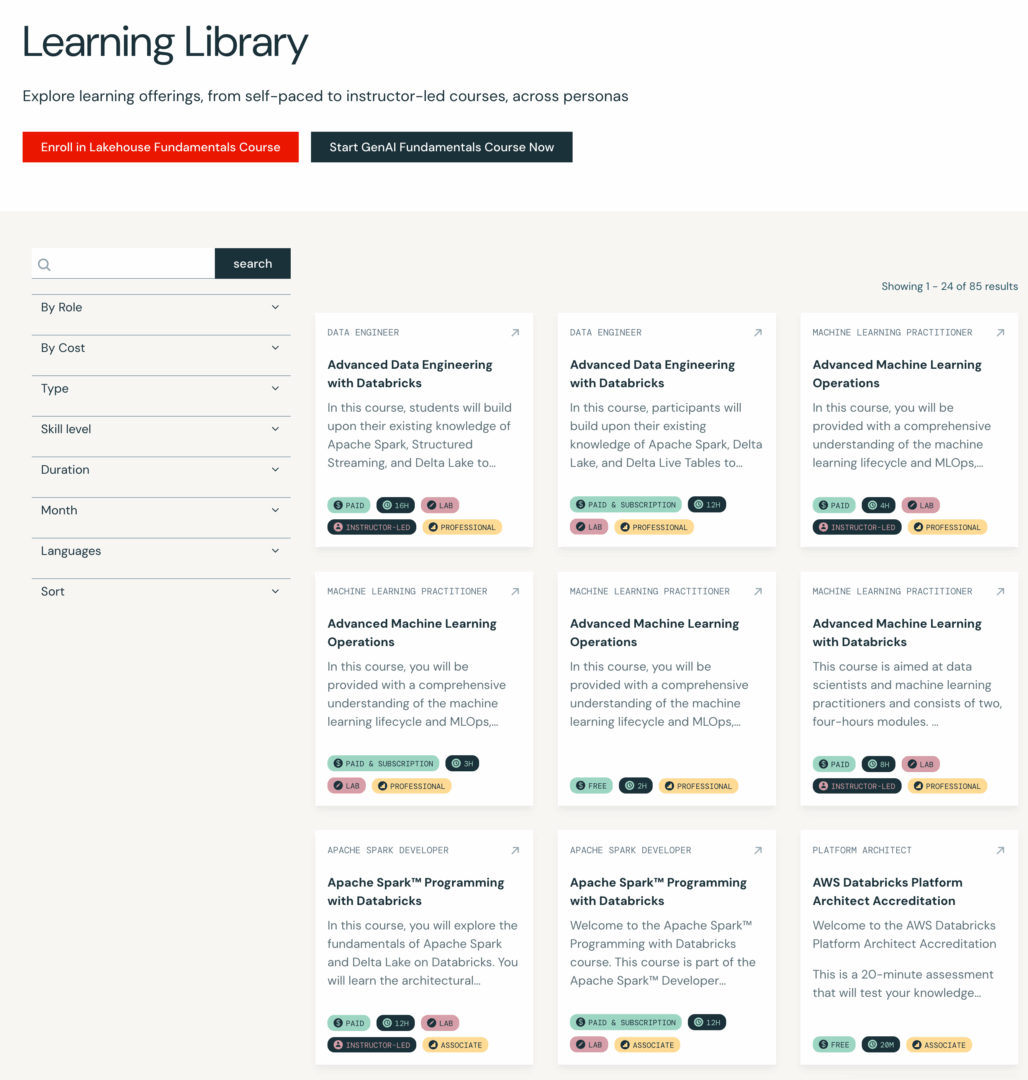
At the time of this analysis, they had 85 courses. Some are free, and some are paid. Free courses and certifications attract potential customers, creating opportunities for Databricks to convert learners into paying clients.
Training helps people use Databricks more effectively, so they are more likely to succeed with it. This makes customers happy and encourages them to continue using Databricks. Training also introduces Databricks to new people and companies, helping Databricks acquire more customers.
We didn’t saw the usual money tier regarding the Academy. If they went on the same path as the other, this would’ve helped users better understand their progression options and potentially increase engagement with more advanced, paid courses after completing initial free training.
Resources center

Some of the content is gated, acting as a lead magnet, and some is free to use.
Take for example, the first e-book:
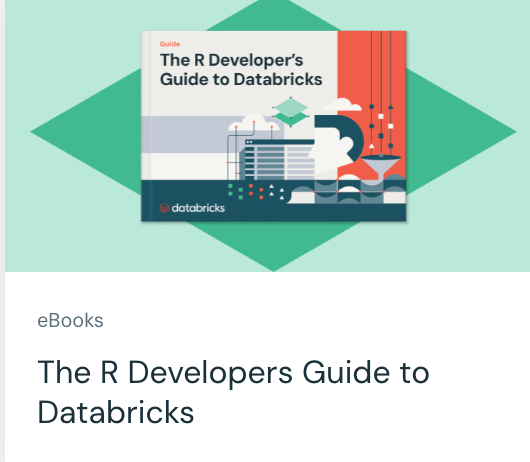
It is a free, quite comprehensive, 86 pages e-book. No download is required, as it opens as a PDF in the browser. At the end of the e-book, they include a sales pitch. It begins with a company introduction and then transitions into a CTA for readers to start a free trial, encouraging immediate engagement with the Databricks platform.
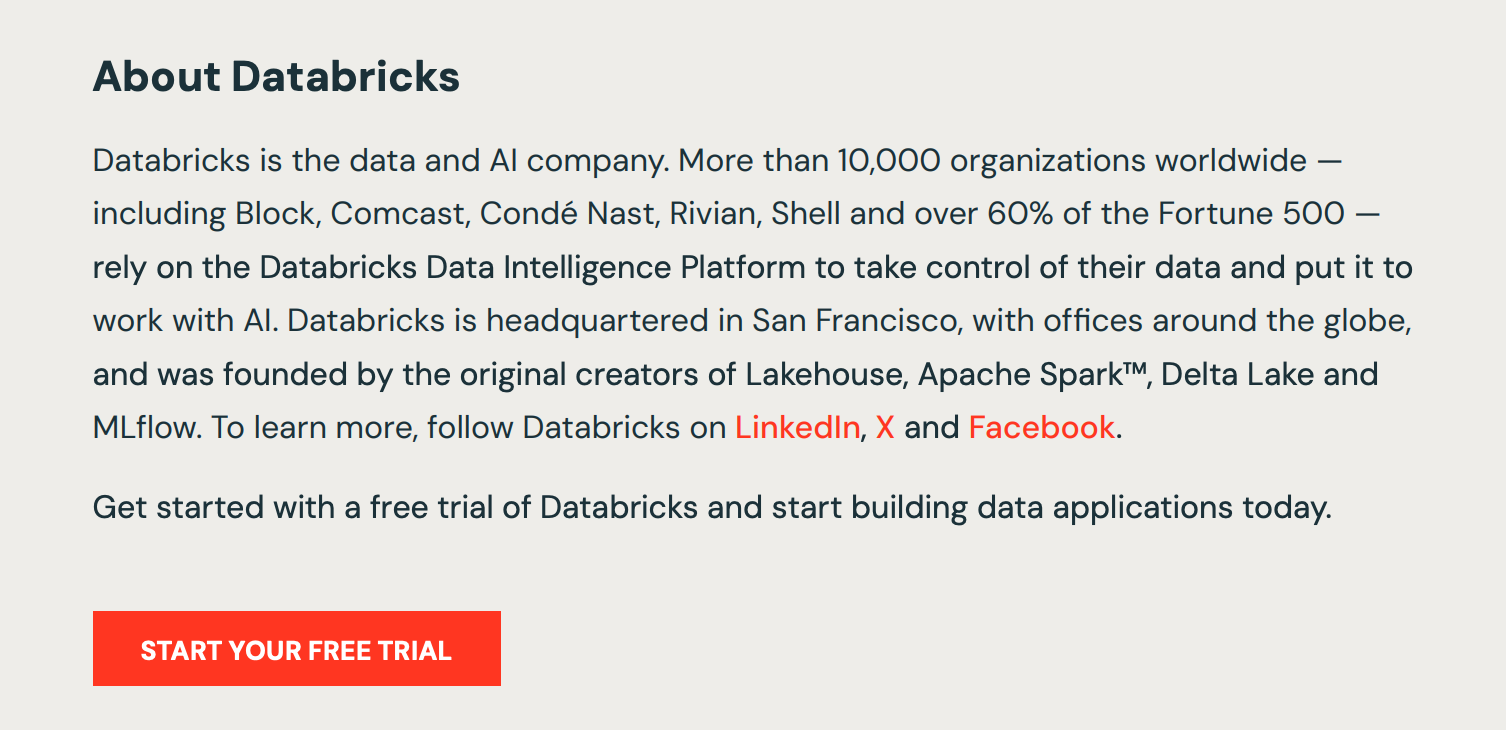
This orange button directs leads to the “create an account” page. The free trial offered by Databricks can be seen as a lead magnet. To access the trial, users need to sign up with their work email, allowing Databricks to collect lead information.
The goal is to let potential customers experience the platform, with the hope of converting them into paying customers after the trial period.
Demo center
The demo center is part of their resources.
The goal is to educate potential customers on how to use the platform effectively, increasing the likelihood of them becoming paying customers. When they understand its functionality and see its potential benefits, they are more confident in their decision to purchase. This facilitates their conversion into paying users.
The Value Proposition here is: “Bite-size overviews. Interactive product tours. Hands-on tutorials”.
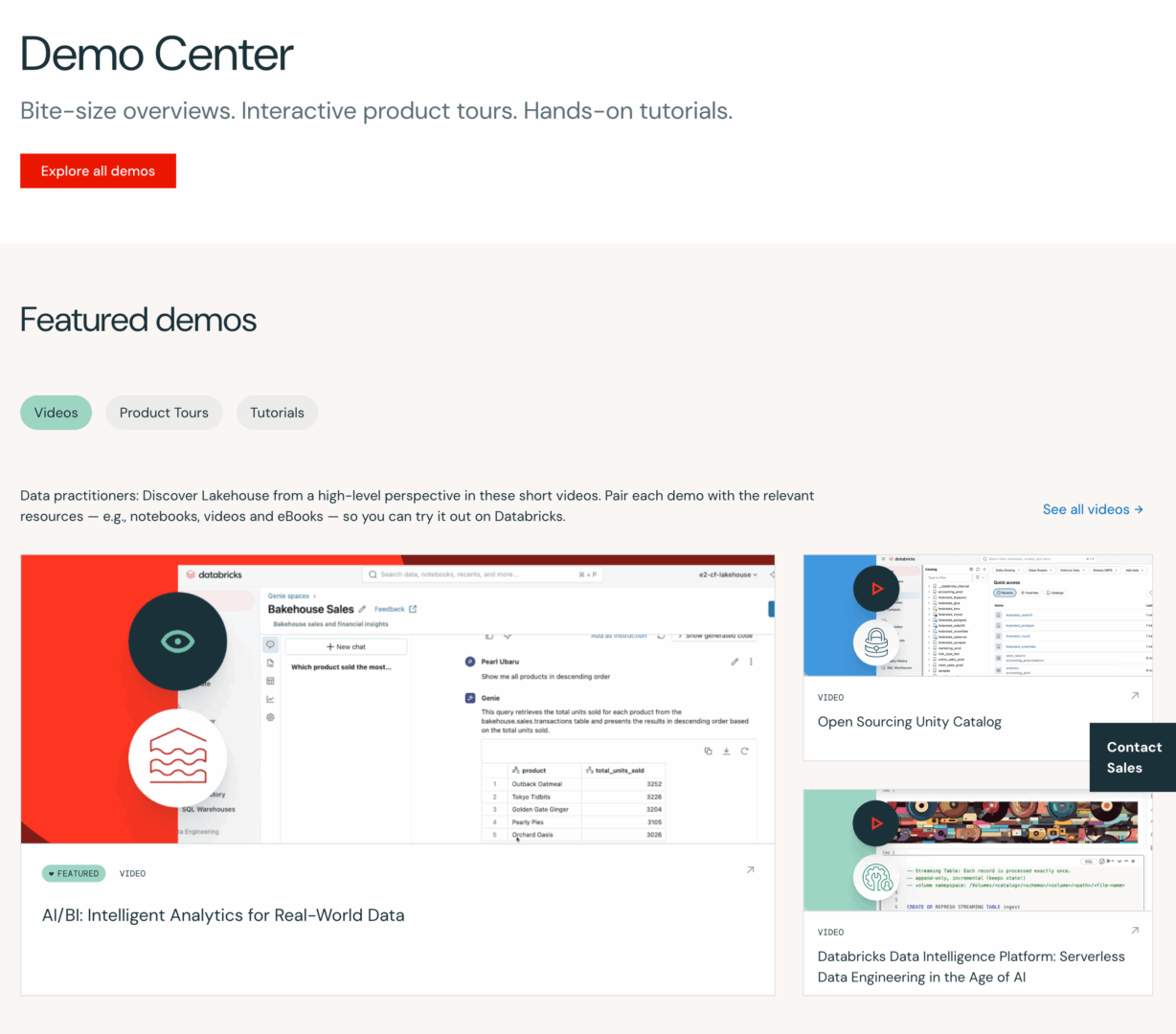
For the demos, they offer videos, product tours, and tutorials, catering to different learning styles and preferences. This increases the likelihood of engagement.
They also have several CTAs: “Start free training,” “Explore all demos,” and “Contact Sales” are clear calls to action, guiding users toward further engagement with Databricks.
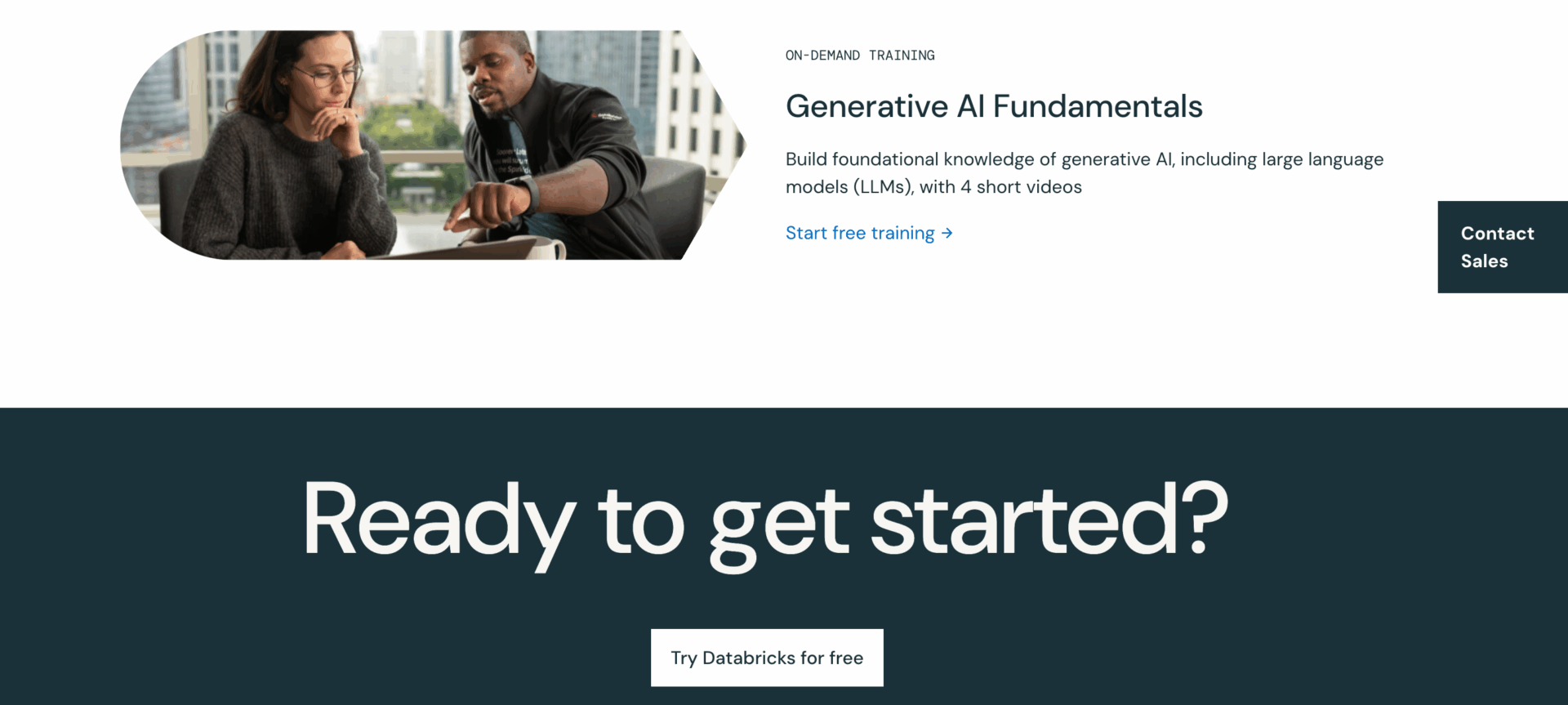
It’s a great, easy way for potential customers to get to know the platform and what it can do. The mix of videos and tutorials means there’s something for everyone, and the clear calls to action make it simple to take the next step. Plus, it’s right there on the home page, so it’s clearly important to them.
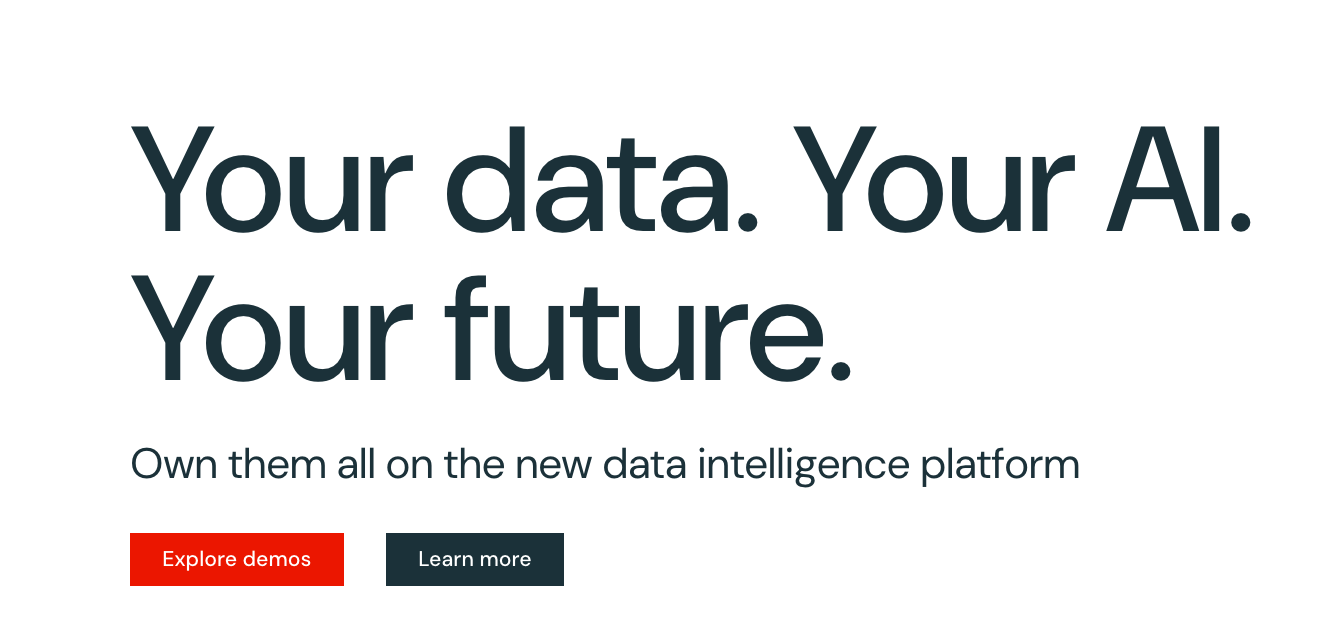
Newsletter

The Databricks newsletter is tucked away in the Resources section. There’s no description, so we’re not quite sure what kind of insights we’d get by subscribing. Adding a quick description would be helpful.
They’re clearly trying to understand their leads as well as possible, asking for job title and company email. This helps them qualify leads and focus their sales efforts.
The “What would you like to hear about?” section lets users pick and choose the email categories they’re interested in. This gives them control over their inbox and makes them more likely to stay subscribed and actually read the content.
Events
Each event has a dedicated landing page. They keep the page of the events up-to-date.
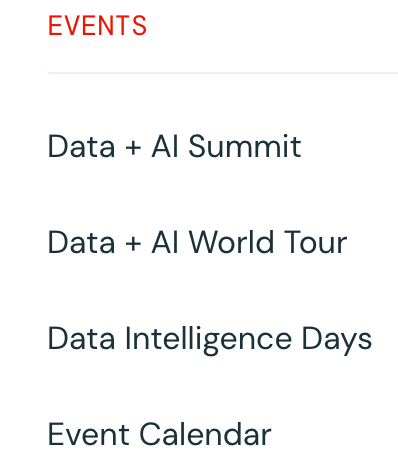
They have a “collection” of events gathered in the “Event Calendar”. On this page users can browse all upcoming events or filter by Event Type and Region.
The page shows various event formats:
- Webinars (e.g., “Scaling Actuarial Data Management”, “How Banks are Modernizing Risk”)
- In-Person Events (e.g., “Data Intelligence with Azure Databricks” in Montreal)
- Workshops (e.g., “Databricks SQL in Action”)
- User Group Meetups (e.g., “Bringing Together Databricks Community” in Nuremberg)
This page could be seen as a lead generation tool. Each event registration captures potential customer information.
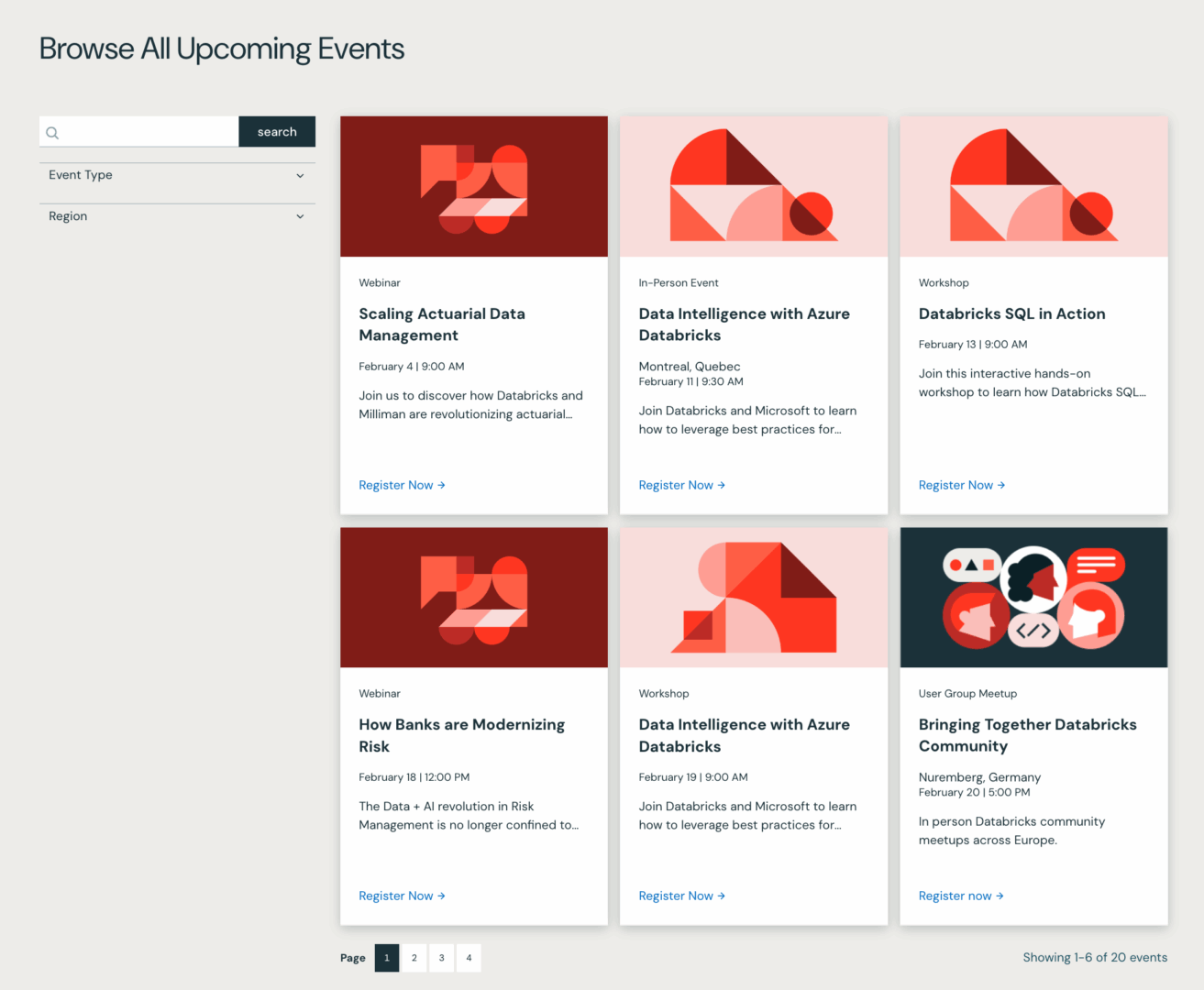
Consider developing a two-tier blog strategy similar to Databricks’. By maintaining both a general business blog and a technical deep-dive blog, you can effectively engage different stakeholders within your target organizations. Your technical content builds credibility with practitioners, while your business content speaks to decision-makers.
Drawing from Databricks’ content analysis, one crucial enhancement for your content strategy would be incorporating more data-driven storytelling. While creating content, integrate relevant industry statistics and research findings. Content with relevant statistics and data points receives significantly more shares and engagement than content without them. Your prospects are looking for evidence-based insights to justify their decisions to stakeholders.
Transform your resource center into a lead generation powerhouse by strategically gating high-value content. Notice how Databricks balances free and gated content.
Make your virtual events work harder for you by promoting them across multiple touchpoints on your website, especially on high-traffic pages.
Ready to take your demand generation to the next level? Start by implementing one or two of these strategies and gradually build your program. The sooner you begin, the sooner you’ll see results in your pipeline growth and customer engagement metrics.
Lead generation
Overview
Databricks definitely uses a lot of calls-to-action. You can spot several right on the main page. The “Try Databricks Free” button is their main conversion CTA, aimed at folks ready to give the platform a try.
The language they use is pretty straightforward and non-technical, so it appeals to a wide audience, including executives and business leaders.
Landing pages
1. “Try Databricks”

With this landing page users can create an account to try their platform. They highlight the key benefits, like creating Generative AI applications, simplifying data ingestion, and querying data with everyday language, all focused on what the user gets.
The “Trusted by” section provides social proof.
The “Try Databricks” button is prominently displayed both at the top and bottom of the main page. And, as you might remember, the “Try Databricks for free” CTA also appears in the blog post section.

2. Downloadables
As we have said, the resource page includes some downloadables, acting as a lead magnet. These resources have a dedicated landing page.
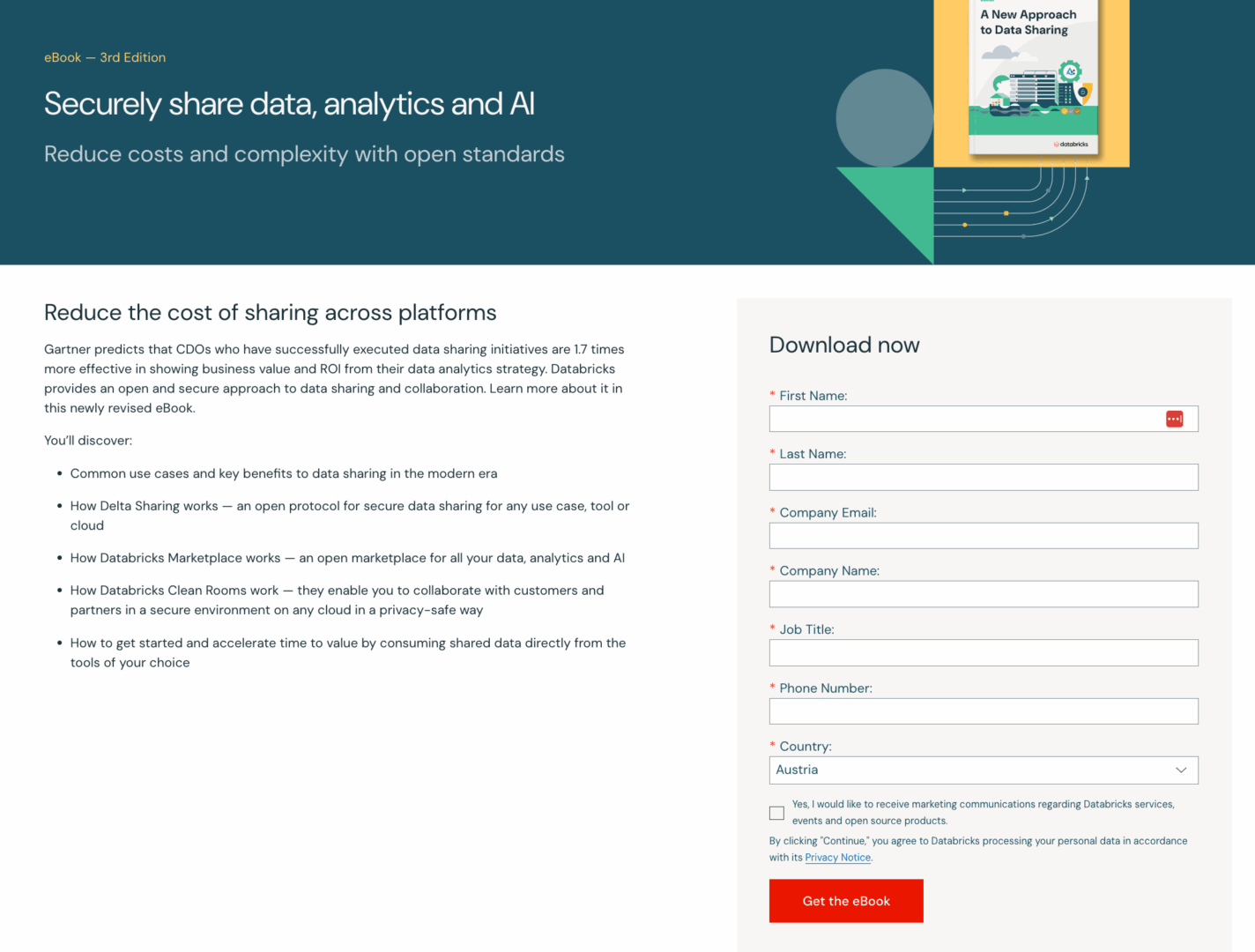
This landing page is designed specifically for lead generation, offering a free eBook in exchange for contact information. It highlights the eBook’s topic: securely sharing data, analytics, and AI, while emphasizing cost and complexity reduction through open standards.
The copy also explains what the reader will gain from the eBook, including use cases, Delta Sharing, Databricks Marketplace, Clean Rooms, and practical implementation advice.
A clear and simple “Download now” call-to-action button leads to the form. The form itself is straightforward, requesting essential contact details (name, email, company, job title, phone, and country). Company email addresses and job titles help Databricks qualify leads. They can identify if the person downloading the eBook is a good fit for their target customer profile. For example, they might prioritize leads from individuals with job titles like “Data Engineer,” “Data Scientist,” “CIO,” or “Head of Analytics” at companies of a certain size or in specific industries. Here is another example of a landing page.
For ABM strategies, where they target specific high-value accounts, knowing the job titles of individuals within those accounts is essential. This allows them to personalize their outreach and target their marketing efforts more effectively.
Webinars
Their webinars are not “freely” accessible, as the leads need to input their contact information.
All their webinar pages have the same structure:
- Introduction
- What will you discover
- Who are the speakers
- The form
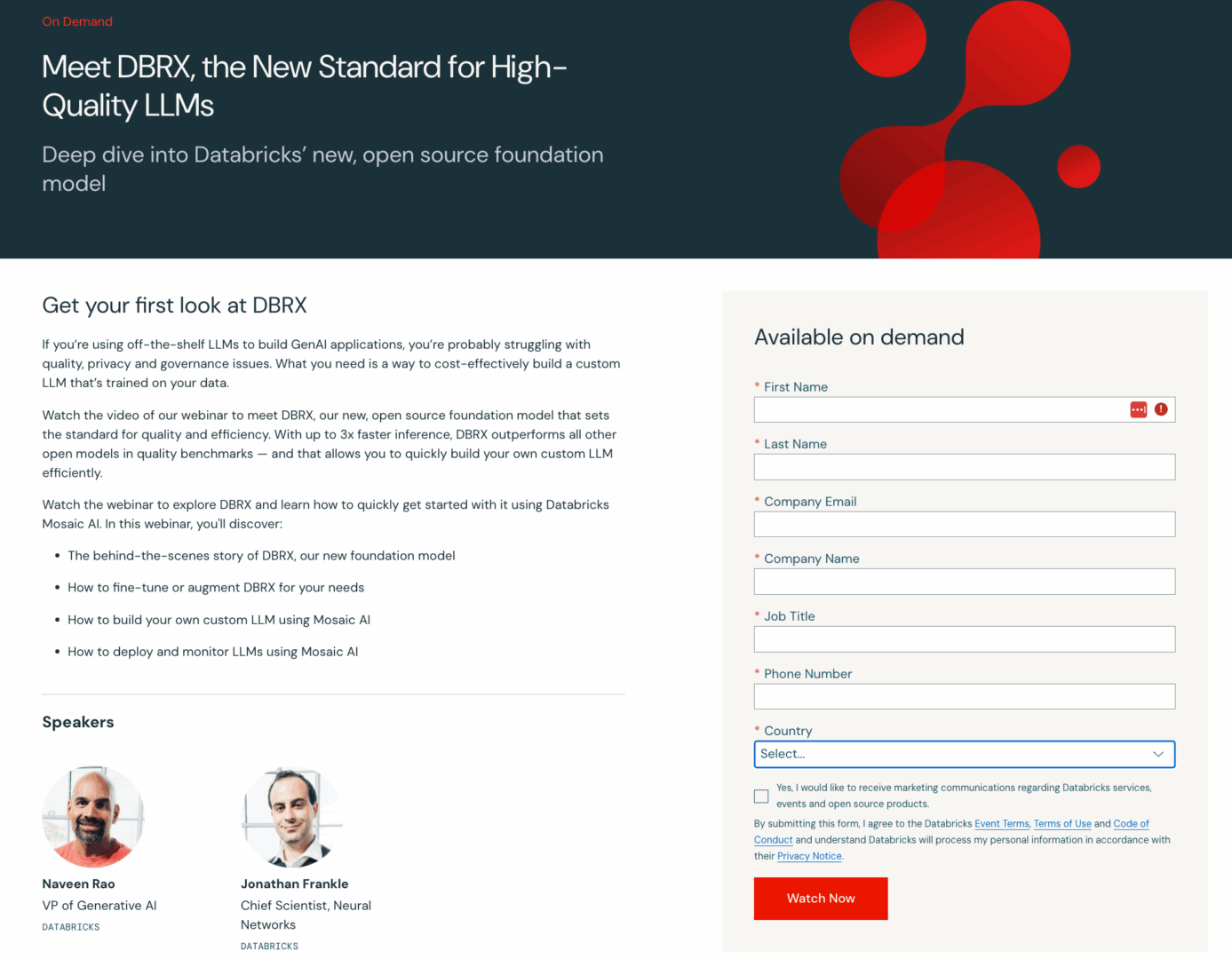
Podcasts
They have two podcasts.
1. Data Brew (which can be found on YouTube).
They’re also promoting it on LinkedIn, which is great. We like that they’ve included a little intro about what the podcast is all about: “In this series, we explore various topics in the data and AI community and interview experts in data engineering and data science. So join us with your morning brew in hand and get ready to dive deep into data and AI”. Sounds inviting!

They have a dedicated Youtube channel for it, with 256 subscribers.
The length of the podcast is around 30 minutes, and until now they have 37 episodes. Their episodes gather around 1.3K views.
2. Champions of Data + AI
For this podcast, they don’t have a dedicated YouTube page. They use the official channel and include the podcast in a playlist. They have 25 episodes, but they haven’t posted in a year.

Paid ads
LinkedIn Ads
Databricks currently has 834 ads running. Lead generation is the primary goal. The ads drive traffic to landing pages where users fill out a form to access content, that’s how they capture leads. The content acts as a “lead magnet”, encouraging users to share their information.
The ads cover a range of data and AI topics, from generative AI and large language models to data engineering and ETL.
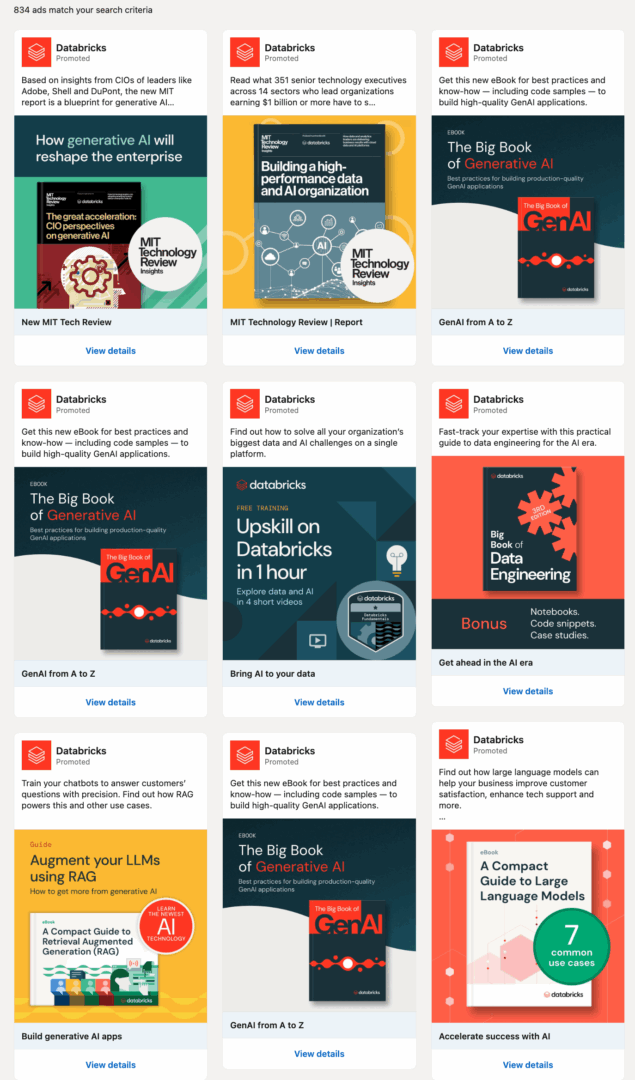
Some of the ads promote their e-books and guides. In these cases, the leads are sent to the Databricks website to fill out a form to access the content.
Other ads, like the one below, promote their reports.

Again, when we click the “Download” button, we’re taken to their webpage to fill out a form and download a copy.
Collaborating with reputable organizations like MIT Technology Review and The Economist adds credibility and extends their reach. These partnerships lend authority to their content and associate Databricks with trusted sources.
Facebook Ads
On Facebook, Databricks has around 170 ads.
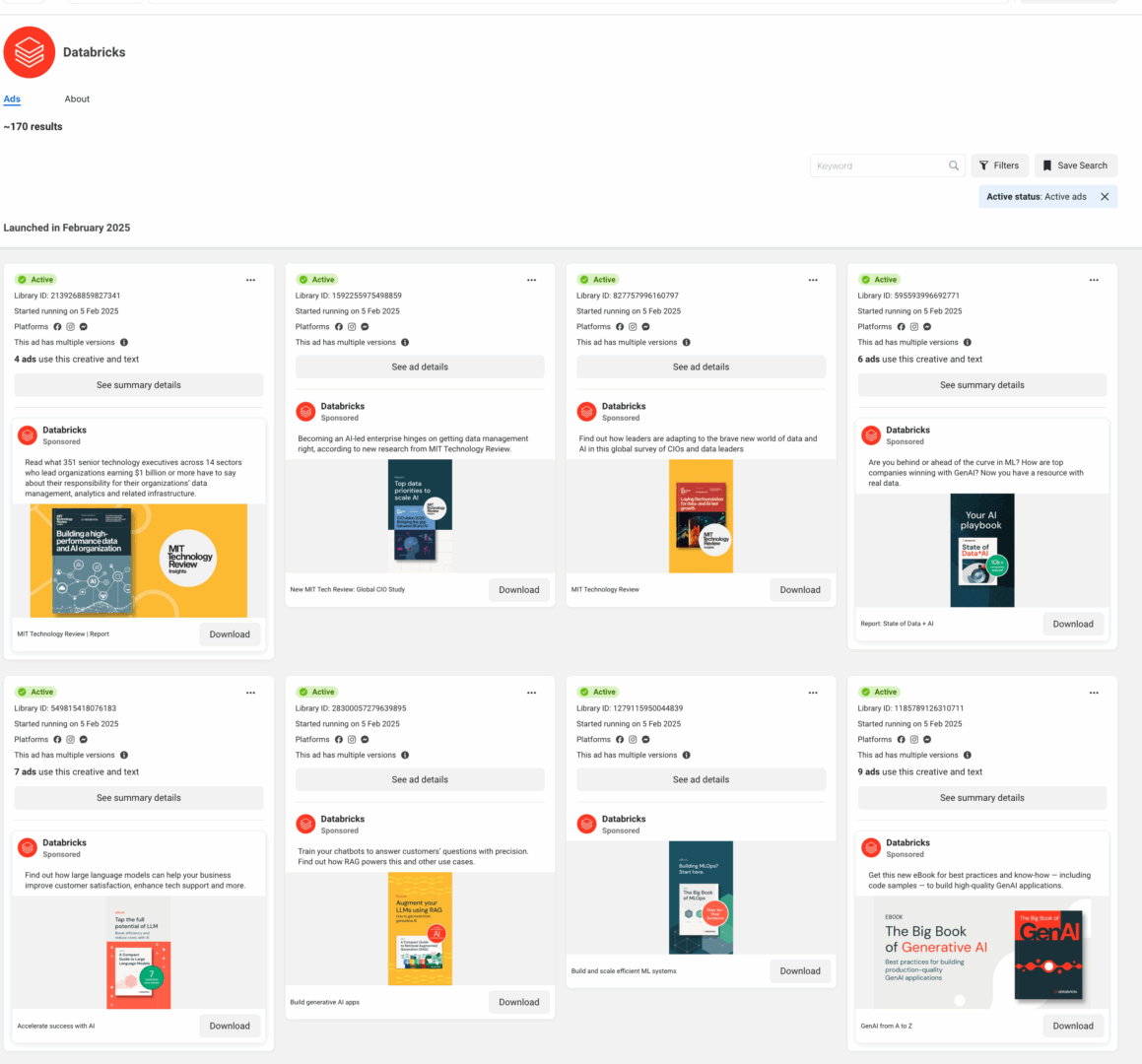
They’ve got 20 active ads running right now. Just like on LinkedIn, these ads are all about promoting downloadable resources: reports, ebooks, guides, and even free online courses. This is a core part of their strategy, offering valuable info in exchange for contact details. The CTA they use is “Download”.
From the little icons, we can tell these ads are running on Instagram, Facebook, and Messenger.
Some of the ads have multiple versions. This means Databricks is A/B testing, trying out different versions of the same ad. They might be tweaking the image, headline, body text, or even the call-to-action to see what works best. Facebook’s ad platform makes this kind of testing easy, so they can optimize how their ads perform.
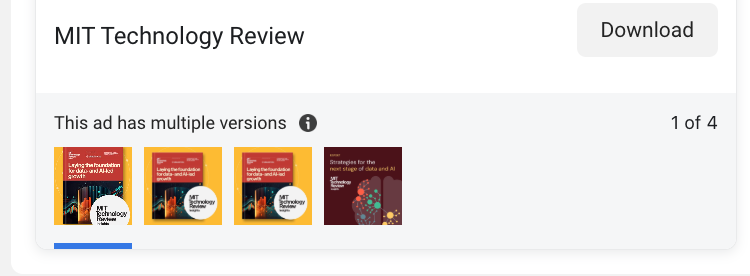
Databricks has a really solid lead generation strategy that other companies can definitely learn from.
Make your website work harder. Databricks uses lots of clear and compelling calls to action (CTAs) all over their site. Think about putting your main conversion CTA in places where it’s really visible, like the top and bottom of your homepage, in your blog section, or wherever leads tend to hang out.
Develop high-quality, downloadable content that acts as a lead magnet. Databricks offers e-books, guides, and reports on topics their audience cares about. Consider partnering with an authority in your field and creating something together, like Databricks did with WEF or MIT. This content should give real value to potential customers while letting you capture their contact info. And don’t forget to create dedicated landing pages for these resources.
Conclusions
Strategy overview
Their core strategy includes a robust lead generation approach, which involves offering valuable content like e-books and webinars in exchange for contact information. They also leverage paid advertising on platforms like LinkedIn and Facebook to promote these resources.
They’re really focused on their Data Intelligence Platform, which is all about bringing data, AI, and governance together in one place. They stand out by showcasing their work with Fortune 500 companies and highlighting their impressive list of investors.
On social media, their CEO is quite active, sharing updates and connecting with industry leaders. While their CMO isn’t as visible, his presence still helps build relationships and promote Databricks’ content.
What interesting things do they do?
- DatabricksTV: They’ve got this platform for community-produced videos. It’s all about getting the community involved and educated. A lot of the videos focus on specific features or updates, like the one on the “Simplified Compute UI”. This helps users keep up with the latest and encourages them to use the new stuff. Basically, Databricks wants people to become pros on their platform, which leads to more usage and happy customers.
- Databricks University: This section is for professors who want to teach using Databricks tools and resources. They offer curated curriculum content, training materials, sample notebooks, webinars, and other pre-recorded content for teaching data science and data engineering. The goal? To establish Databricks as a thought leader in the data and AI world.
What about your company? Ready to transform your marketing and sales strategy? Our team at Milk & Cookies Studio specializes in helping B2B SaaS companies like yours create and deploy digital marketing strategies that drive real growth.
We understand the unique challenges and opportunities in the tech space, and we’re here to help you reach your business goals with our #NoBS approach.
Let’s work together to create a strategy that not only meets your needs but exceeds your expectations. Reach out to us today, and let’s start cooking up your success story!
Frequently Asked Questions
1. What is Databricks and what does it offer?
Databricks is a data intelligence platform that integrates data, AI, and governance. It helps businesses build AI applications, democratize insights across teams, and reduce operational complexity and costs.
2. What makes Databricks different from other data platforms?
Databricks sets itself apart with a unified approach to data and AI, its trusted partnerships with Fortune 500 companies, strong investor backing, and a clear mission to make AI accessible to both technical and non-technical users.
3. How active is Databricks on social media?
Databricks maintains a strong presence across LinkedIn, YouTube, X, and Instagram. They publish a mix of thought leadership, product updates, event coverage, and educational content, especially excelling on LinkedIn and YouTube.
4. How does Databricks generate leads?
Databricks uses gated resources (ebooks, reports), webinars, virtual events, product demos, and training academies. Their lead generation strategy is supported by dedicated landing pages and targeted ads across multiple platforms.
5. What can B2B marketers learn from Databricks’ content strategy?
B2B marketers can learn the value of multi-channel content marketing, combining educational blogs, executive branding, and video content to build credibility, foster community engagement, and generate high-quality leads.


